29 FEBRUARY – 18 MARCH 2024
By Dylan Vasapolli
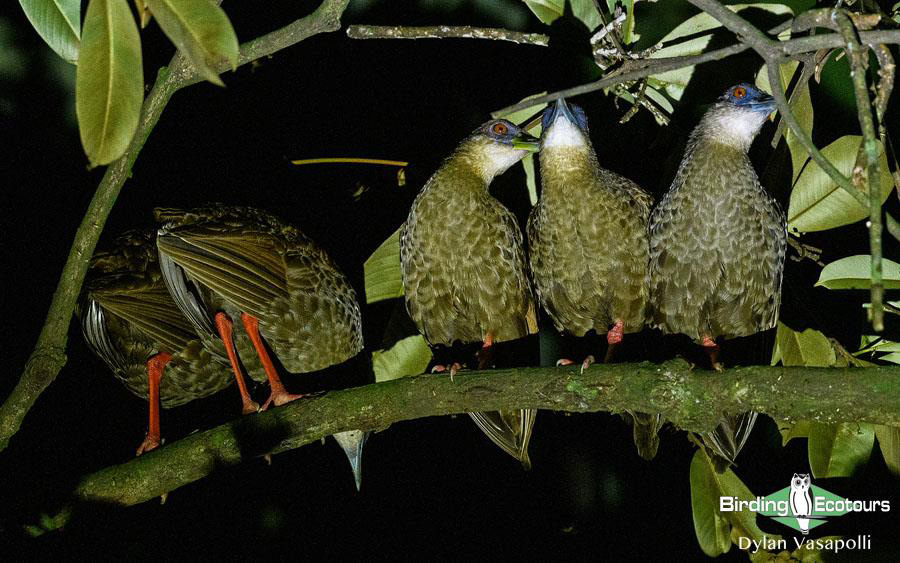
The rare Nkulengu Rail is one of the most under-rated Ghanian specials – virtually nowhere else is this strange forest rallid seen.
Overview
Ghana is one of the only stable and safe West African countries, and this makes it a key destination for any world birder, offering a host of otherwise rare and localized species not possible elsewhere. This set departure tour to Ghana was booked out by a private group, and is a comprehensive tour, covering virtually the entire country. Due to some of the long distances needed to get from the coastal forested habitats, to the dry Sahel country in the far north, this tour was tweaked from previous versions, and incorporated a domestic flight from the north of the country, back to Accra, cutting out the better part of two days of non-stop travel, allowing us to have more time for birding.
All in all, the tour went ahead smoothly and largely to plan, and combined with our local guide, Philip, we amassed an incredibly high tally of birds. While some of the well-known high priority specials like White-necked Rockfowl and Egyptian Plover were well seen, many other less-known species were also found. The many forested sites held the likes of Nkulengu Rail, Rufous-sided Broadbill, Congo Serpent Eagle, Western Dwarf Hornbill, Brown Nightjar, Violet-backed Hyliota, Blue-moustached Bee-eater, Chocolate-backed Kingfisher, Forest Wood Hoopoe and Preuss’s Weaver. The wooded Mole National Park was superb, and gave us the incredible Standard-winged Nightjar, alongside other great birds like Brown-rumped Bunting, White-fronted Black Chat, Sun Lark, Forbes’s Plover, African Spotted Creeper, White-throated Francolin, Black-faced Firefinch and so many more. The dry Sahel country in the north gave us a further boost with the likes of Yellow Penduline Tit, Chestnut-bellied Starling, Speckle-fronted Weaver and Northern Carmine Bee-eater. Much time was devoted to finding owls and nightjars as well, and this is reflected in the high number of both that we recorded.
A detailed daily account can be read below, and the full bird and mammal lists are located at the end of the report.
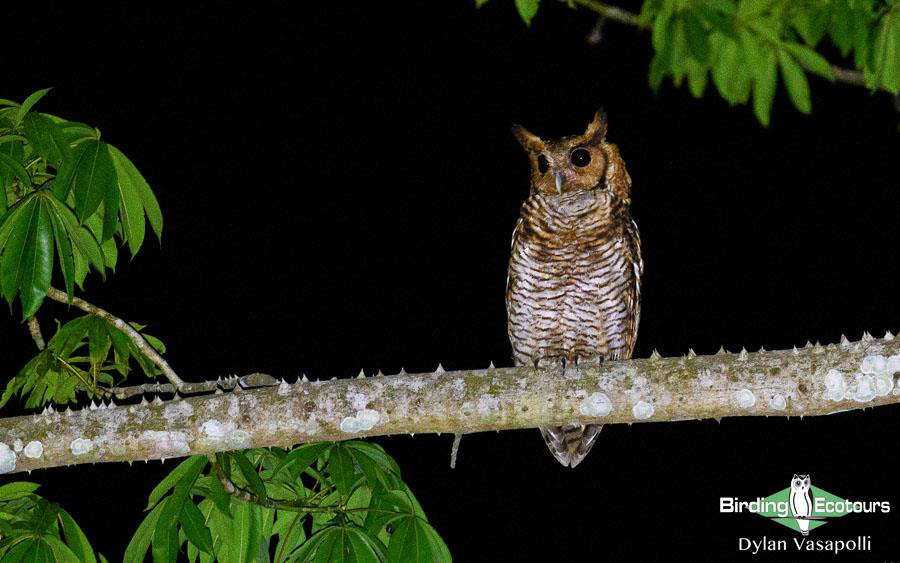
Fraser’s Eagle-Owl was one of many owl species seen on this tour.
Detailed Report
Day 1, 29th February 2024. Arrival into Accra, and transfer to Shai Hills
Following the group’s morning arrival, we immediately transferred out the city to our first hotel. The late afternoon saw us entering into the Shai Hills Reserve, and starting our birding. We explored some of the wooded areas first, which gave us our first birds like Yellow-fronted Tinkerbird, Northern Puffback, Yellow-throated Leaflove and Village Weaver. A fruiting tree held many birds, and we spent some time sitting and watching what came and went. A small flock of the scarce Red-headed Lovebirds was a pleasant surprise, with a large grouping of Violet-backed Starlings constantly jumping about. We also picked up the snazzy Double-toothed and Vieillot’s Barbets along with the bright Splendid Sunbird. Our first of many White-throated Bee-eaters was seen nearby, before we found the hulking Bearded Barbet and the sought-after Violet Turaco. We headed towards a rocky cliff, where flyby Senegal Parrots obliged, as did a Swallow-tailed Bee-eater. With the sun setting, we continued deeper into the reserve, finding many Double-spurred Spurfowls along the track, until we reached our final point. As it got dark, we ventured out to try our hand at some night birds. We were blown away with the diversity of nocturnal birds we could hear from this single spot, with Fiery-necked (Black-shouldered), Freckled, Swamp and Long-tailed Nightjars, along with Western Barn Owl, African Scops Owl and African Barred Owlet all calling simultaneously. While it was incredible to hear all these different species calling around us, we struggled to see them, with only Fiery-necked Nightjar showing itself. Eventually, we started making our way out the reserve, and enjoyed many nightjars sitting in the track, with Plain, Long-tailed and a lone Freckled Nightjar all showing well. We settled in for the evening, following a full first day of birding.
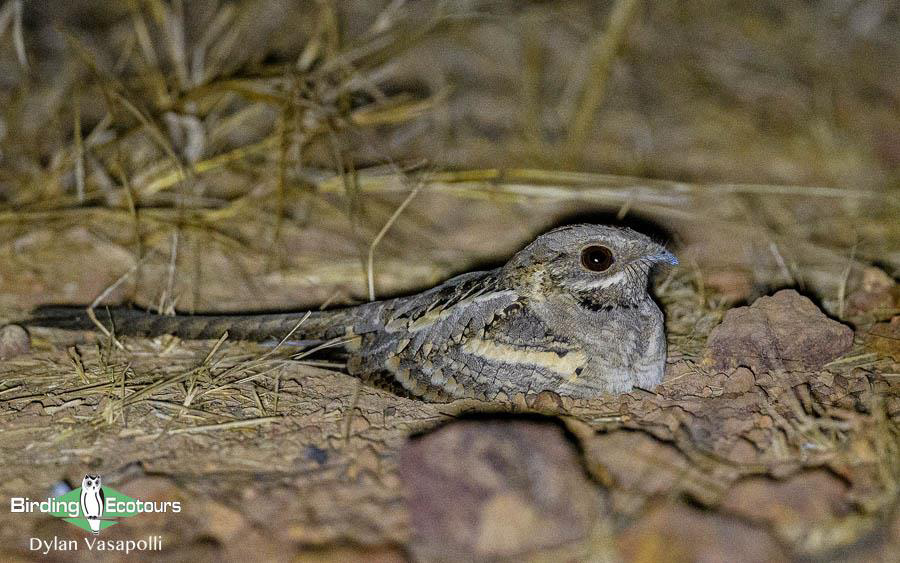
We had good sightings of Long-tailed Nightjar (amongst others) on our night drive.
Day 2, 1st March 2024. Birding from Shai Hills to the Atewa Range
We had another morning of birding in the Shai Hills Reserve close to our lodge. It was a birdy morning, and we started off by working some of the denser thickets which yielded a group of Blackcap Babblers and a shy Guinea Turaco, along with several Brown-throated Wattle-eyes and a quick Grey-headed Bristlebill. Oriole Warbler was heard, but try as we might, we were unable to lay eyes on this species. The more open wooded areas held similar birds to yesterday, with White-throated Bee-eater and Violet Turaco proving highlights, though we added the stunning Blue-bellied Roller, African Grey Hornbill, Black-crowned Tchagra, shimmering Purple Starlings, Yellow-throated Longclaw and a fine Whinchat. Several raptors were seen moving over the rocky hills, with Red-necked Buzzard, Lanner Falcon and African Hobby all showing well.
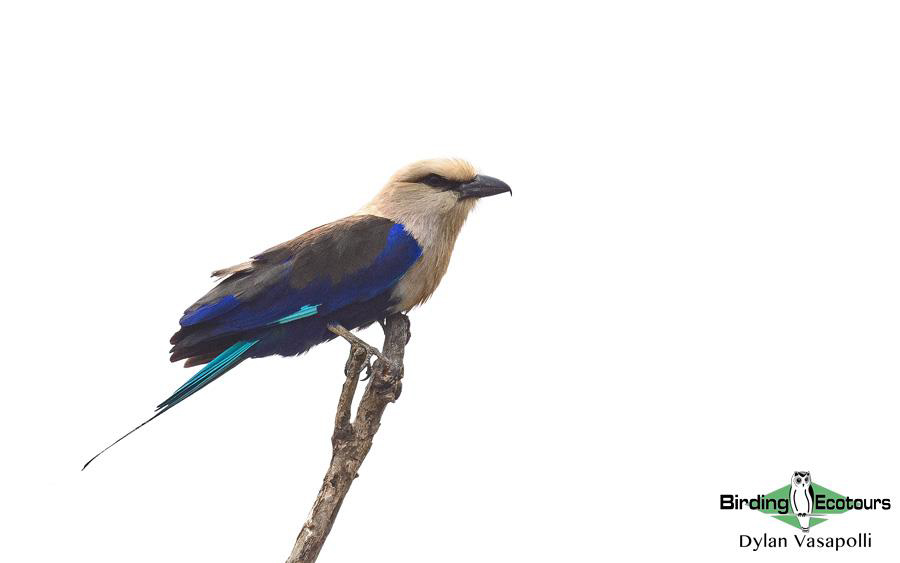
Blue-bellied Roller provided a refreshing hit of color.
With the heat building up, we retired back to our lodge, where we had a short rest, followed by lunch, before checking out, and pressing on to our next destination – the Atewa Range. After settling in at our new hotel at a bustling roadstop, we ventured out into some nearby farmscrub habitat on the edge of the forests, where we would spend the afternoon. Despite its degraded appearance, this edge habitat is usually very productive offering a host of scarce birds. Right from stepping out the car, we were scrambling to get views of the sought-after Compact Weavers that were fiddling around a marsh, while patient Orange-cheeked Waxbills afforded us all good views. Delightful African Pygmy Kingfishers showed well, and we found the first of many West African Pied Hornbills. Flyby Tambourine Doves gave us good views, as did some perched African Green Pigeons before our first Black Bee-eater put in an appearance – this species a major hit with the group. Many seedeaters were moving about, and we enjoyed large flocks of Thick-billed and Chestnut-and-Black Weavers, while dainty African Firefinches and Olive-naped Weavers kept to the denser areas. Before long, with the sun setting, we called it a day.
Day 3, 2nd March 2024. Forest birds of the Atewa Range forests
This is arguably the most arduous day of the trip, with the long and steep hike up through the Atewa Range forests testing everyone’s physical (and mental) ability. These forested hills have slowly been transformed, and now a long hike is needed to get to the more mature, and productive interior forests, which are home to several scarce birds. Much of the early part of the trail was spent walking, all in a bid to get as deep and far into the forests, as early as possible, but we forced a few stops for some birds. Our first stop was to find a calling Tessmann’s Flycatcher, which took a bit of effort to locate, but showed well in the end. Here, a flood of other birds came through thick and fast, and we quickly notched up many other species, finding it difficult to even move a few steps further along. These included the lovely Black Bee-eater, African Emerald Cuckoo, Yellow-throated Tinkerbird, Buff-spotted Woodpecker, the tiny Lemon-bellied Crombec, Black-capped Apalis, Slender-billed and Golden Greenbuls, Fraser’s Forest-Flycatcher, Red-headed Malimbe and Chestnut-breasted Nigrita.
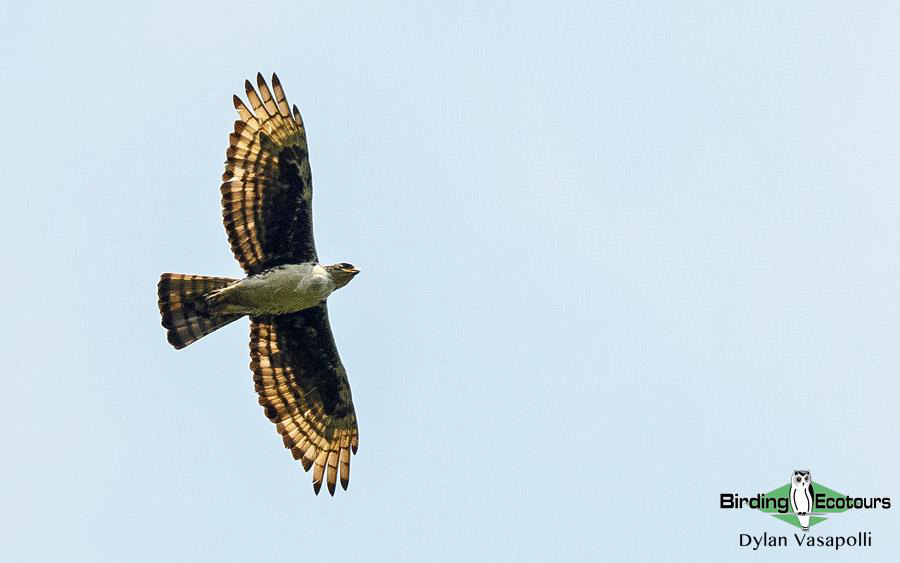
Cassin’s Hawk-Eagle is a scarce raptor of forests – we were fortunate to get excellent views.
Large flocks of Maxwell’s Black Weavers were seen regularly as we continued up, and we pulled out other key species like Narina Trogon, Thick-billed Cuckoo, Melancholy Woodpecker, West African Wattle-eye, Yellow-browed Camaroptera, Chestnut-capped Flycatcher, Chestnut-winged Starling, and several sunbirds including Yellow-chinned, Collared, Blue-throated Brown and Johanna’s Sunbirds, at our many rest stops. After some stiff hiking, we eventually reached the top of the range, and almost immediately found one of our main targets, the rare Blue-moustached Bee-eater. We soaked up our views and watched the bird for a time, before moving onwards, and finding a second bird further along. Another of our targets, the equally rare Nimba Flycatcher, eluded us. With time ticking, we had to call it, and start the long trek back down the mountain. With the day nice and warm now, the birding had slowed down, but we still continued adding new birds, with the huge Black-throated Coucal skulking about in some thickets giving us all some views, along with a family of the tiny Tit Hylias coming in and out of their nest, while Blue Malkohas dashed through overhead clearings and a fine Cassin’s Hawk-Eagle flew low over the forest. After reaching the bottom of the mountain, we climbed on our bus, and headed back to the hotel, where we took it easy for the rest of the day.
Day 4, 3rd March 2024. Birding Atewa, and transfer to Accra
With a short travel day on the cards, as we ultimately made our way back to Accra, we had the full morning available to us, to explore the mixed farmbrush habitat and forest edge, on the lower slopes of the Atewa Range. It was a birdy morning, as we continued adding new birds to our list whilst enjoying now ‘regulars’ as well. We spent a long while working many difficult and shy birds, like Kemp’s Longbill, Brown Illadopsis and Blue-shouldered Robin-Chat – all master skulkers in their own right – and enjoyed views to a greater (or lesser) extent of all of them. Several others were close misses, like Red-cheeked Wattle-eye and Yellow-footed Honeyguide, which were heard repeatedly, but not seen. We also added several others like Klaas’s Cuckoo, Blue-breasted Kingfisher, both the strange Bristle-nosed and Naked-faced Barbets, Marsh Tchagra, Western Nicator, Finsch’s Rufous Thrush, Dusky-blue Flycatcher and Black-winged Red Bishop. All in all, a very successful morning.
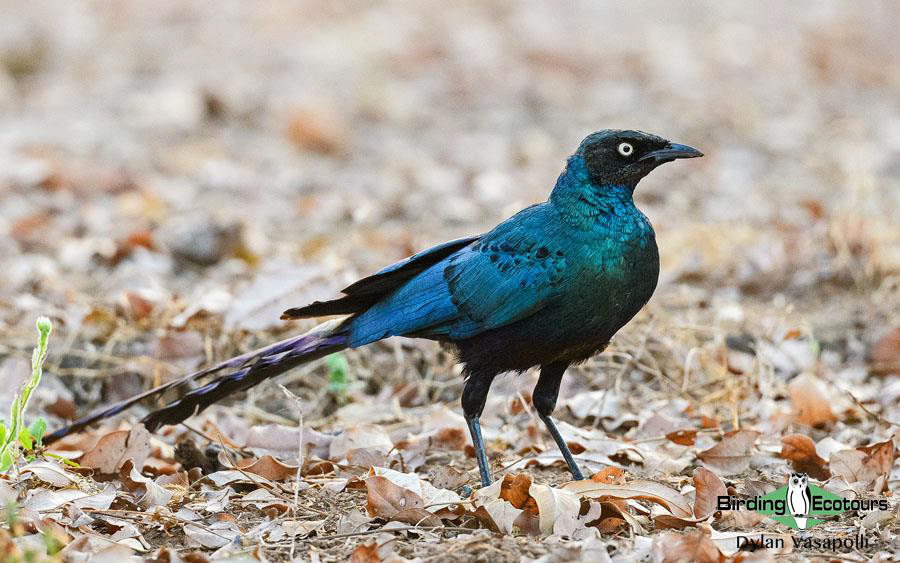
Bright Long-tailed Glossy Starlings were seen in the botanical gardens.
We collected our things from the hotel, had an early lunch, and set off back to Accra, where we arrived in the mid-afternoon. We had a bit of time for some afternoon birding, and ventured off to the nearby Legon Botanical Gardens where we enjoyed some more casual birding. The large dam held numbers of Senegal Thick-knees, along with various egrets and herons, including Squacco and Striated Herons and Black-crowned Night Heron. Dashing Woodland Kingfishers showed well, as did Pied Kingfishers. The open areas held groups of noisy Long-tailed Glossy Starlings and Western Plantain-eaters, while comical Northern Red-billed Hornbills danced around. The denser thickets produced a fine pair of Guinea Turacos, along with a surprise Blue-breasted Kingfisher, while groups of Piping Hornbills commuted overhead. The stunning White-crowned Robin-Chat was lured from its thicket, and a group of Brown Babblers showed well.
Day 5, 4th March 2024. Birding Winneba and transfer to Kakum National Park
We had a particularly early start – necessary to get out of Accra before the morning traffic started. We called in at the Winneba Lagoon, where a very low tide greeted us. We patiently scanned through the vast mudflats that were now showing, on this tidal lagoon, and enjoyed practicing our shorebird identification. Common Ringed Plovers were easily the most numerous species, but other common species that were well represented were Grey (Black-bellied) Plover, Eurasian Whimbrel, Common Greenshank, Ruddy Turnstone and Sanderling. Carefully picking our way through all of these gave us further species like Bar-tailed Godwit, Marsh Sandpiper, Common Redshank, Curlew Sandpiper and Little Sting. Numbers of Collared Pratincoles were seen flying overhead but kept their distance. Waterbirds like the quick-running Western Reef Heron lined the waterways, while small numbers of Common Terns were present, though sadly, no other terns could be found. Several Western Yellow Wagtails were seen as well.
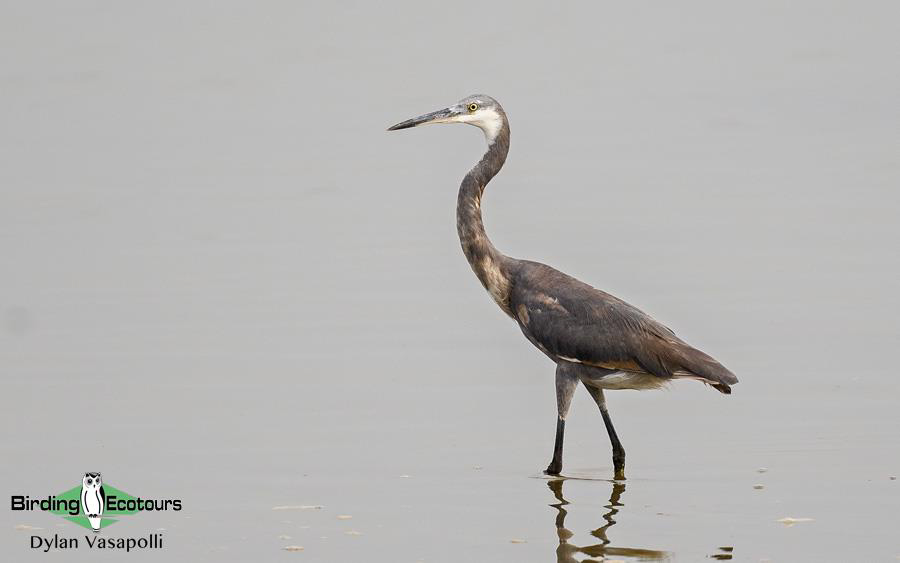
Western Reef Herons were commonly seen around the coastal wetlands, like Winneba.
After our morning around Winneba, we continued on to our comfortable lodge, located near the famous Kakum National Park, where we would spend three nights. We had a midday break, before undertaking a late afternoon foray into some of the surrounding lowland forest for our first dose of Kakum. It was a hot afternoon, and the bird activity was relatively subdued with little calling and being seen. A small Ussher’s Flycatcher sat atop the canopy on its exposed perch got our account running, and both Naked-faced and Bristle-nosed Barbets also vied for attention on nearby exposed perches as well. Just like that, the birding changed. A woodpecker tapping led us to a family of Fire-bellied Woodpeckers, and a high-pitched call led us to a fine Blue Cuckooshrike. A tiny Red-rumped Tinkerbird showed well, before a group of Red-billed Helmetshrikes came floating by. In the late afternoon, several hornbills became active, and we did well picking up the scarce Western Long-tailed Hornbill, along with numbers of Brown-cheeked Hornbills. We stayed to try for the elusive Brown Nightjar, and while we heard them, we were unable to lay our eyes on them. A close encounter with Fat Burrowing Asp (Fat Stiletto Snake) halted us on our way back to the vehicle, from where we called it a night.
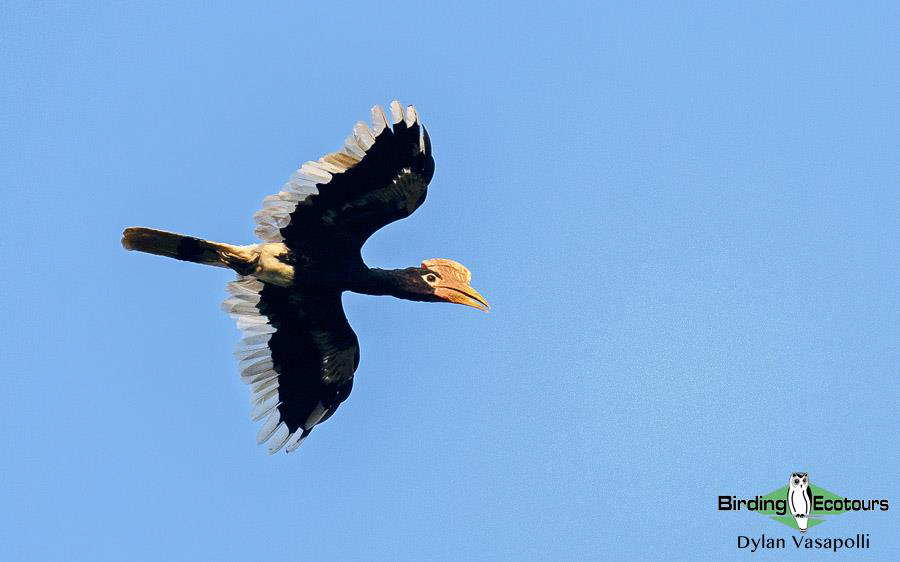
Large Brown-cheeked Hornbills were active, flying by in the late afternoon.
Day 6, 5th March 2024. Birding from the Kakum canopy walkway
Our first full day of birding around Kakum was focused entirely on the main part of the world-famous canopy walkway, where we had extended morning and afternoon sessions birding from its platforms, towering high above the forest. After negotiating the steep climb up to the top, getting onto the canopy walkway was easy by comparison. Here a network of platforms was interconnected by suspension bridges, and we spent some time birding from each of the various platforms. While patience is the name of the game here, as you wait for birds to come by and into view, a careful eye is rewarded, and we had a superb day. Hornbills were a dime a dozen thanks to our carful scanning, and regular West African Pied Hornbills aside, we enjoyed several Western Long-tailed Hornbills, along with two of the scarce Western Dwarf (Black Dwarf) Hornbills, along with multiple groups of Brown-cheeked Hornbills, several of the enormous Black-casqued Hornbills and a few of the prized Yellow-casqued Hornbills. Cassin’s Honeybird and Willcock’s Honeyguide showed very well, while our views of West African Batis and Violet-backed Hyliota left a bit to be desired. A huge roving party of some 30+ Spotted Greenbuls brought some life to the trees, while we also carefully picked out Honeyguide, Yellow-whiskered and Ansorge’s Greenbuls from a fruiting tree. Tiny Sunbirds were conspicuous on the suspension bridges gathering spiders’ webs for their nests, and the equally minute Forest Penduline Tit showed well. Some flowering bushes held several sunbirds we were now familiar with, and produced an excellent male Buff-throated Sunbird as well. The raptors were a bit slow, unfortunately, and some of the hoped-for targets such as Long-tailed Hawk and Congo Serpent Eagle remained unseen, though we did enjoy African Harrier-Hawk, Palm-nut Vulture and European Honey Buzzard. We tried another site at dusk for Brown Nightjar, and while we got closer to the calling bird, we went on another night without actually laying eyes on it.
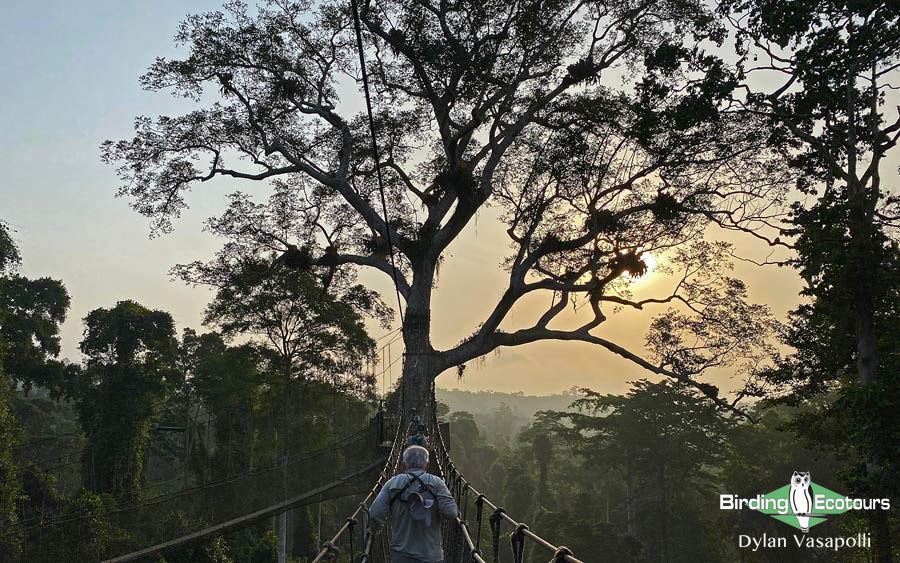
Birding from the canopy walkway in Kakum offers unparalleled access to the forest birds.
Day 7, 6th March 2024. Birding Kakum surrounds
Following our full day on the Kakum walkway the previous day, we opted to spend the day birding some of the other areas surrounding Kakum. Our morning at the Abrafo Forest was spectacular, netting us many of our missing targets here. A few quick stops in the always-productive farmbrush habitat on the forest edge gave us some new birds from Red-bellied Paradise Flycatcher to Whistling Cisticola, and dainty Bar-breasted Firefinches to bold Red-vented Malimbes.
Before long, we were on the trek into the forest, and immediately heard one of our targets, Rufous-sided Broadbill. After some careful positioning we found the bird, and enjoyed some good scope views of this special species. Chocolate-backed Kingfisher was our next target, and we were on a roll with some careful scanning revealing this bird perched in the open for all to admire. A large swarm of ants moved through and brought the forest undergrowth to life, with Red-tailed and Grey-headed Bristlebills giving us brief views, Yellow-bearded Greenbuls showing well and the shy White-tailed Alethe giving us all prolonged views. An open clearing held a long Black Bee-eater and a Blue-throated Roller, before a Congo Serpent Eagle called nearby, resulting in us backtracking after the eagle. While we did not find the eagle, we gradually made our way back out the forest, and onwards to another area we would scan the surrounds from.
This yielded large numbers of Rosy Bee-eaters, along with an Ayres’ Hawk-Eagle, but little else in the now sweltering heat. A quick stop at a productive stream gave us a surprise Shining-blue Kingfisher, before we heard the tell-tale calls of White-spotted Flufftail. We dug our way deeper into the vegetation, and found a suitable spot from which to scan. Here we tried to tape in the flufftail, and while some of the group were able to get some views, not everyone managed to see it, unfortunately. We vowed to try again. Following our now customary midday siesta, we resumed our afternoon birding and headed off into the forest once more. We had a mixed afternoon as, while it was quiet for the most part, we had short bursts of activity, with highlights going to good looks at the regional special, Copper-tailed Starling, along with multiple looks at the tiny Tit Hylia, the subtly beautiful Sharpe’s Apalis, the snazzy Swamp Palm Bulbul and a lone White-headed Woodhoopoe. We tried once more for our nemesis, Brown Nightjar, and this time were finally rewarded with excellent views, before retiring for the night.
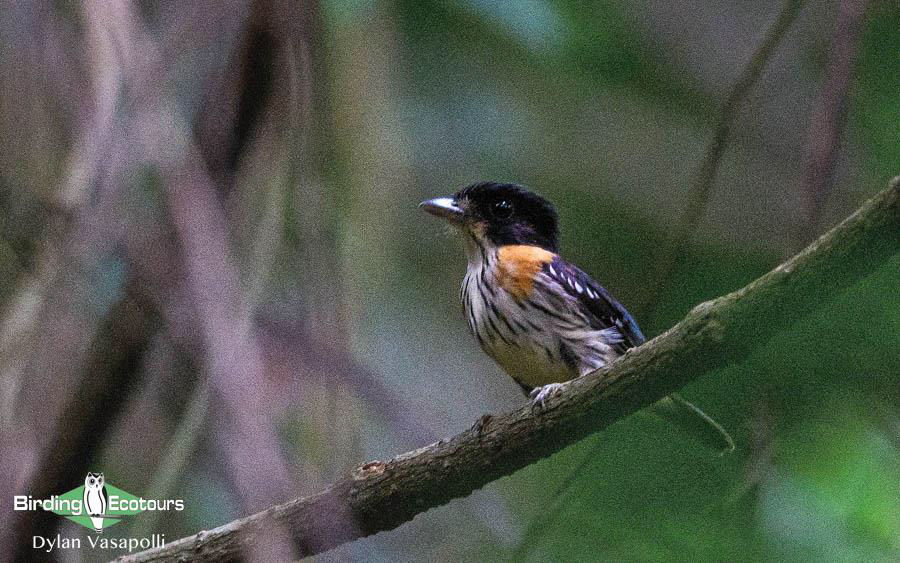
Watching this Rufous-sided Broadbill about to launch into its display flight was a highlight.
Day 8, 7th March 2024. Kakum birding, and transfer to Ankasa
With a full day of mixed birding and travel, we set off at dawn and started our morning off in some nearby farmbrush habitat. Here we were looking for some of our missing edge species, like Black-bellied Seedcracker and Baumann’s Olive Greenbul, amongst others. A Red-chested Goshawk started the morning off, before enjoying the antics of the many Yellow-mantled Widowbirds, Black-winged Red Bishops and the array of weavers, mannikins, firefinches and waxbills all starting their day. Small wooded thickets held some exciting birds like Buff-spotted Woodpecker, Brown-throated Wattle-eye, Green Crombec and several Green-headed Sunbirds. Other open areas produced an excellent Marsh Tchagra, before finally finding a Black-bellied Seedcraker – though the bird disappeared quickly not to be seen again. Other birds like Blue-headed Coucal, Mottled Spinetail, Giant Kingfisher and several Rosy Bee-eaters were all enjoyed.
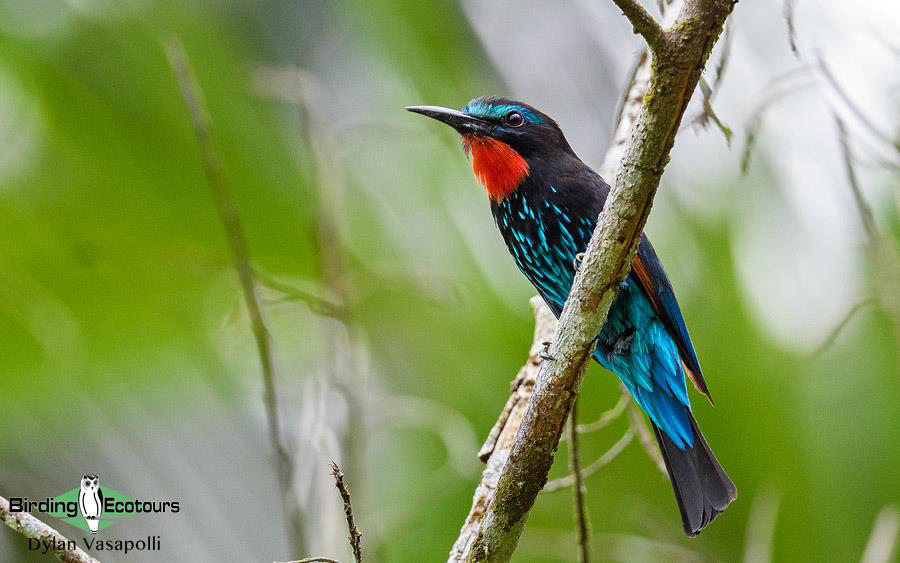
Much to the groups’ delight, the gorgeous Black Bee-eater was regularly seen throughout the first part of the trip that focused on forest birding.
We then shot off to some further sections of the Kakum forests where we would spend the rest of the morning. We had done well in the forests, with many of the species seen, and new birds were few and far between. A pair of the tiny African Piculets showed for us, though they proved very difficult to track down in the tall trees, while we also finally bumped into a flock of Red-fronted Parrots. Some other forest birds seen included familiar birds like Bristle-nosed Barbet, Black-winged Oriole, Grey Longbill, Golden Greenbul, Copper-tailed Starling, Red-headed Malimbe, Maxwell’s Black Weaver and Blue-throated Brown Sunbird, while others like the strange Fraser’s Sunbird and Yellow-mantled Weaver were also picked.
We had an early lunch, and then set off on the long road bound for the lowland forests of the remote Ankasa Reserve. Ponds on the route produced a few waterbirds, notably African Pygmy Goose, Allen’s Gallinule, Black Crake, African Jacana and a small colony of the scarce Orange Weaver. Nearby mangrove areas held some exciting birds like Hartlaub’s Duck and the Mangrove Sunbird, while a brief African Finfoot exploding out of the cover didn’t afford much time to take it in. We rolled into our exquisite lodge on the edge of the forest in the late afternoon.
Days 9 – 10, 8th – 9th March 2024. Mega birding in Ankasa
We had two full days of birding in the incredible Ankasa National Park. This remote forest block offers one of the most intact segments of lowland forest in West Africa, and supports important populations of many scarce specialties, very difficult elsewhere. The birding here is, however, notoriously difficult, with much effort needed to reap the rewards. Some of our time was spent around some forest pools deep within, which gave us incredible views of the difficult White-bellied Kingfisher, along with numerous Shining-blue Kingfishers, a fine Dwarf Bittern and secretive Blue-billed Malimbes. We also spent our evening waiting at the ponds for the rare Spot-breasted Ibis to come in to roost. Frustratingly, we heard these birds on both our full day evenings, as they commuted overhead, but they were always away from where we were positioned, and we missed laying eyes on this rarely-seen species. The forests around the pools were productive and held close-feeding Yellow-billed Turacos, parties of Western Bearded Greenbuls and snazzy looking Yellow-spotted Barbets. We also finally caught up with the scarce Congo Serpent Eagle here, though our views left a bit to be desired for some. The ponds also had several Dwarf Crocodiles in attendance.
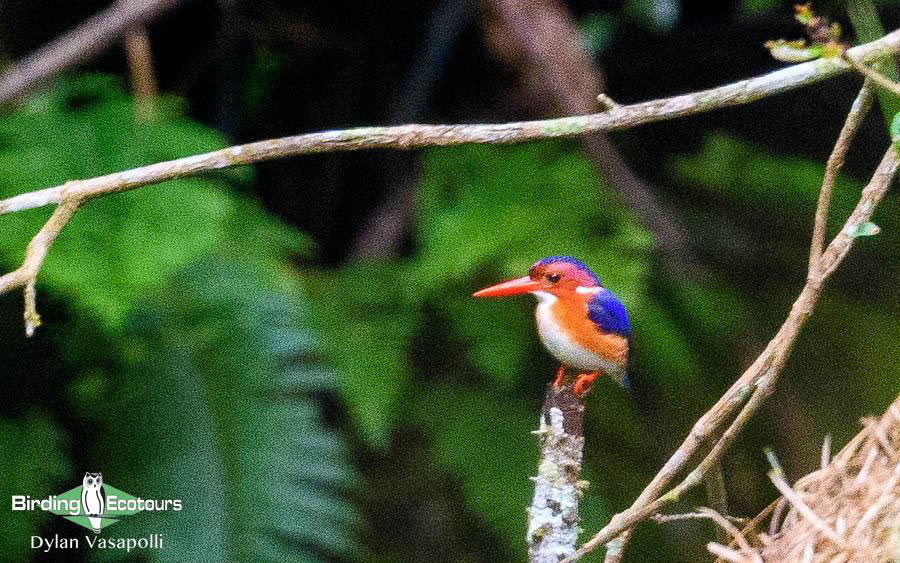
A record-shot of the rare White-bellied Kingfisher – a species regular at some of the ponds deep within the lowland forests at Ankasa.
Exploring the forested trails leading deep into its heart gave us some stunning birds, like parties of Red-billed Dwarf Hornbills, a showy Rufous-winged Illadopsis, bright Shining Drongos, drab Icterine Greenbuls, shy (Orange-breasted) Forest Robins and skittish Red-chested Owlets. Many others were seen along the trails, including several other greenbuls, illadopses, malimbes, flycatchers, sunbirds and so many more. Birding along the main road was fruitful as well – aside from producing excellent views of Blue-headed Wood Dove, we ran into a confiding Dwarf Bittern and even bumped into the rare White-crested Tiger Heron – what a thrill! Keeping an eye on the sky, whenever possible, netted us the scarce Bates’s Swift, along with more regular species like Sabine’s and Cassin’s Spinetails and Square-tailed Saw-wings. Our lodge gardens weren’t exempt from birds either, and the resident Black Bee-eater pair that nests in the grounds added a constant hit of color. Reichenbach’s Sunbird was another special that showed well in the grounds, as did the diminutive Forest Penduline Tit.
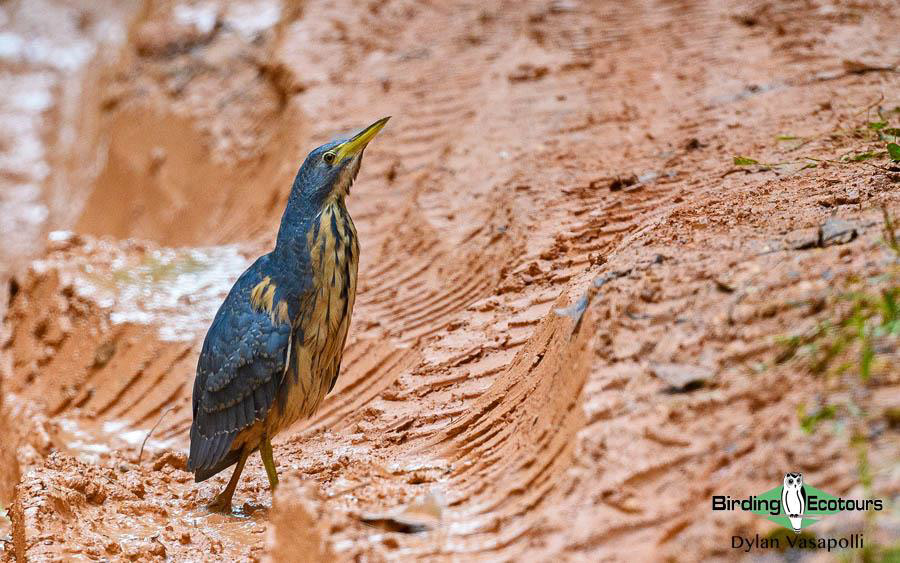
A Dwarf Bittern carefully watches us from the muddy road verges.
The mega Nkulengu Rail is arguably one of the biggest attractions to visiting Ankasa, though seeing this bird requires a nighttime foray into the forest and is no small feat. These birds are tracked down at night, with their strange booming calls ringing out, leading us to their roost tree, where they are usually found high up overhead. This doesn’t always go to plan, and it regularly takes several attempts to successfully track them down, due to the complexities of wandering through this dense lowland forest in the dark of night. Indeed, we only managed to find the birds on our second evening attempt, though we were privy to a fine show from a large family group, which we observed for a while. We also undertook night walks after our rail searches, and we were rewarded with stunning views of an Akun Eagle-Owl pair.
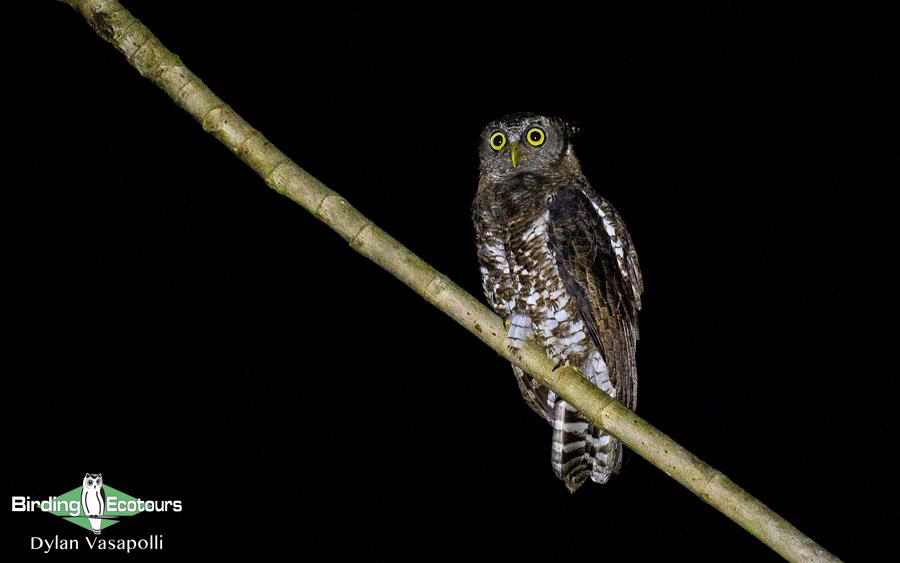
A fine Akun Eagle-Owl showed well to us one evening.
Day 11, 10th March 2024. Final Ankasa birding, and transfer to Kakum
Our time in the lowland forests of Ankasa had almost come to an end and we enjoyed one final morning session here. We had done well, and seen the bulk of the specials on offer, and spent some time trying to track down the scarce species. We started off well, finally finding the massive Great Blue Turaco, before tracking down the ultra-shy Green-tailed Bristlebill – which showed remarkably well to everyone. After a few unsuccessful attempts over the previous days, we also finally laid eyes on Olive Long-tailed Cuckoo. Before long, we were rolling out of the forest, and on the route back to Kakum, where we had been prior to Ankasa. We stopped at the mangrove areas along the route, to try for the African Finfoot again. Though we were unsuccessful on this front, we did find a locally rare Black Heron, along with a wide range of other wetland birds. This is a long transfer, and most of our afternoon was spent driving, until we reached our final birding stop of the day at Brenu Beach. The mosaic of wooded thickets and grasslands here support a wide array of birds. The open areas held bright Little Bee-eaters, while more dedicated searching gave us Red-winged Prinia, Singing Cisticola and Copper Sunbird. The denser stands of thickets were birdy and gave up a showy pair of Tropical Boubous, Orange-breasted Bushshrike and a stunning Western Bluebill. Right at the end of our birding, just as we had given up hope, we found the scarce Pied-winged Swallow. We pressed onto our accommodation, arriving in the early evening.
Day 12, 11th March 2024. White-necked Rockfowl birding
This is arguably the most highly anticipated day of the tour, as we try to see the otherworldly White-necked Rockfowl, though we had the morning to get through before our search for this bird began. We had one final morning in the Kakum National Park district and birded a different patch of forest to where we had been earlier on in the trip. A vocal Puvel’s Illadopsis led us off into the scrub early on in the day, and showed well to all, before we focused on the scarce Red-cheeked Wattle-eye which showed as well. A calling Lowland Sooty Boubou took a long time to show to everyone, giving only brief glimpses at a time. This general area was very birdy, and we enjoyed seeing many other species we were familiar with, including various hornbills, bee-eaters, barbets, greenbuls, sunbirds, weavers and colorful seedeaters like Orange-cheeked Waxbills. We soon found ourselves heading down to a forested swampy area, where we tried for the shy White-spotted Flufftail. In no time, we had a male bird come out and parade around in the open, showing itself off to all. Content, we pressed onward to the Pra River, where we made the obligatory stop for the unique West African race of Rock Pratincole and White-bibbed Swallow. Numerous colonies of Preuss’s Cliff Swallows were seen en-route. In the early afternoon, we pulled into the remote Bonkro village, where we checked into our locally run guesthouse, and had a short rest. Before long, we were out again, this time bound found for the nearby forest, where we would be staking out a huge monolithic rock deep within, where the strange White-necked Rockfowl nests and roosts. We stopped for a few birds along the way, which gave us good views of Rufous-sided Broadbill and West African Wattle-eye, but we were focused on getting to the rock in time. After arriving, we settled in on the benches installed, and began our wait. Right on cue, just before it started getting dark, the first White-necked Rockfowl appeared. We watched the bird go about its business for some time, with a further two individuals joining in. After having our fill, we left the birds in peace, and set off back to our guesthouse. After dinner and a well-deserved cold beer, we headed out for an owling session nearby, which was very successful, giving us excellent (and walk-away) views of both Fraser’s Eagle-Owl and African Wood Owl.
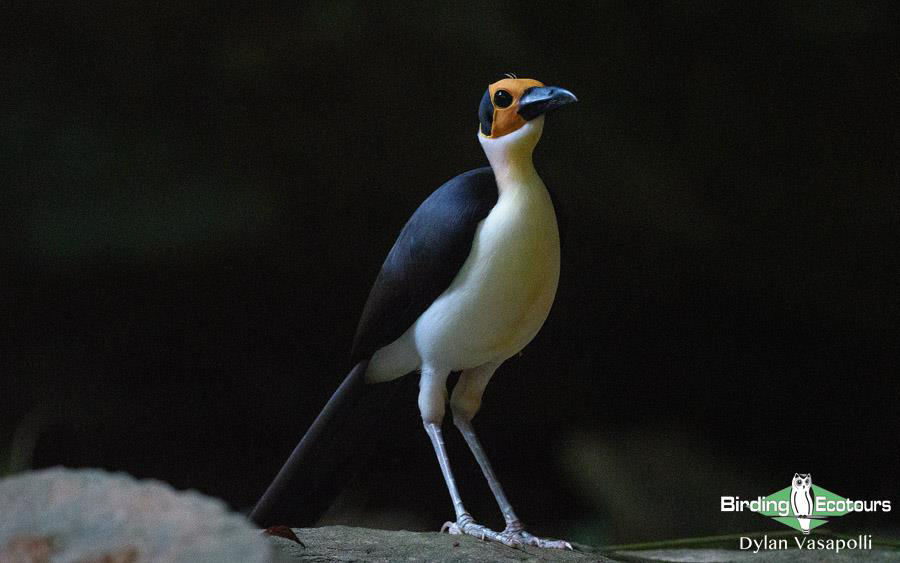
The bizarre White-necked Rockfowl looks like something straight out of the Jurassic Period. We spent a long while with this famous group of birds on this years’ tour.
Day 13, 12th March 2024. Birding Bonkro and transfer to Kumasi
With a short drive ahead of us, we had the full morning available for birding in the Kwabena Sam Forest, just outside Bonkro. Despite the bulk of our tour route so far having been in forest habitat, we still had some key species to try for. It was a mixed morning however, with the intense heat keeping activity low. A family of Fire-bellied Woodpeckers drummed from the treetops, while it took a herculean effort to finally lay eyes on the Yellow-billed Barbet. Red-fronted Parrots commuted up and down, and Blue Cuckooshrikes flitted over clearings. Yellow-mantled Weavers dangled from their nests and, try as we might, a calling Yellow-throated Cuckoo could not be lured into the open. We tried very hard for the scarce Long-tailed Hawk and had to be content with a very brief flyby through the forest, that only some of the group managed to get onto. A wide range of other forest species was seen as the morning went along. Following our lunch, we gathered our things and set off to Kumasi, where we arrived in the mid-afternoon. We enjoyed the rest of the afternoon at leisure.
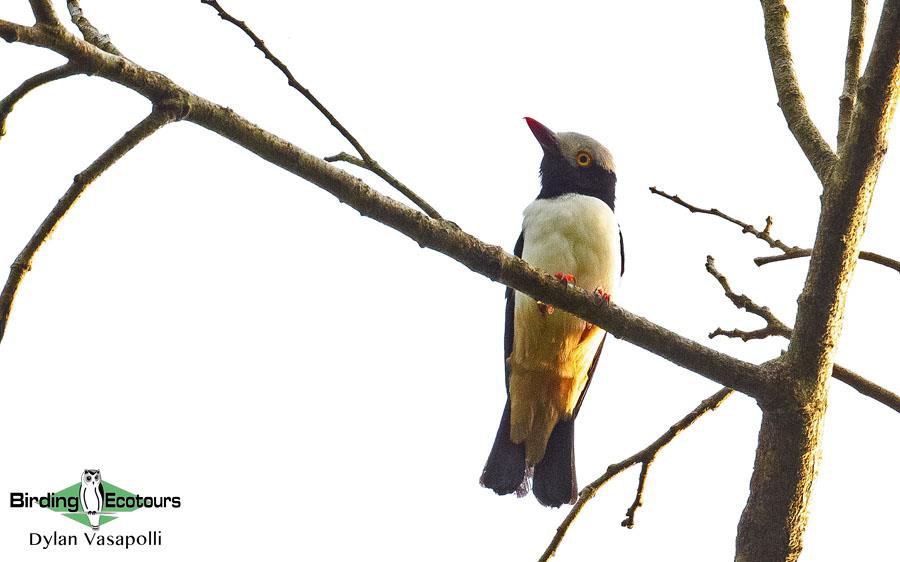
Comical Red-billed Helmetshrikes were commonly seen in many of the forests we visited.
Day 14, 13th March 2024. Birding Bobiri Butterfly Reserve, and transfer to Mole
We were up at it at our usual early hour this morning, as we explored the Bobiri Butterfly Sanctuary. This forest was alive with birds, with West African Pied and Western Long-tailed Hornbills flitting about, noisy Red-billed Helmetshrikes flopping through the trees and fidgety Chestnut-capped Flycatchers bouncing around. We did well to find a group of the scarce Preuss’s Weaver feeding in a huge bare tree, where we also discovered some Grey Parrots – finally! Keeping up with some activity around a clearing produced two stunning Forest Wood Hoopoes for us, and we also finally all got satisfactory views of Finsch’s Rufous Thrush. A number of other birds were seen in the morning, though try as we might, we couldn’t turn up one of our more important BVDs (better view desireds) in Long-tailed Hawk. Soon we had to bid farewell to this lovely forest, and we were fighting our way through Kumasi, bound for the Mole National Park, in the north of the country. This was a long drive and took the rest of the day. A short stop in the Teak woodlands of the old Opra Forest was surprisingly productive, and yielded our hoped-for target, the stunning Fiery-breasted Bushshrike. The bird was a bit secretive but showed to a greater or lesser degree. Others like Northern Puffback, Black-and-white Shrike-flycatcher, Red-winged Prinia, Red-tailed Greenbul, Green Hylia and European Pied Flycatcher showed as well on our short stop. As we headed further north, we picked up our first Grasshopper Buzzards, along with Dark Chanting Goshawks and Booted Eagles. At dusk, we rolled into Mole, enjoying a large covey of some twelve Stone Partridges scurrying around the gate. Excited for our days ahead, exploring a new habitat type, we settled in for the evening.
Days 15 – 16, 14th – 15th March 2024. Birds and animals of Mole National Park
Birding in the diverse woodlands of Mole is nothing short of spectacular, and after having had nearly two weeks of almost exclusively forest birding, we were all thrilled with this change, and the high diversity that greeted us. We spent some time working the ponds and thickets below the old school Mole Motel. Being at the end of the dry season, the water was quite low, however, we did well eking out a few specials like Greater Painted-snipe, Green Sandpiper and Malachite Kingfisher, while other common species like Great Egret, Grey Heron, Spur-winged Lapwing, Black Crake, African Jacana and numbers of White-faced Whistling Ducks were also present. The best was yet to come, and we could scarcely believe it when we bumped into the rare White-backed Night Heron, giving the group brief, but good, views before melting away deep into its thicket.
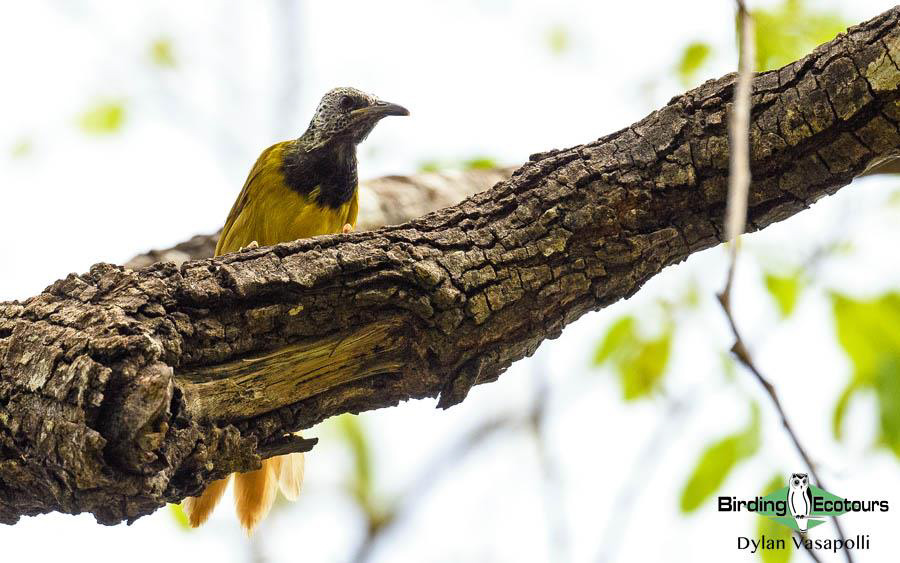
The strange Oriole Warbler took some time and effort to locate.
The surrounding woods were very birdy and gave up many excellent species. Bright Red-throated Bee-eaters and colorful Grey-headed Kingfishers were obvious, and the fidgety African Blue Flycatcher and strange Oriole Warbler played hard ball – though both eventually showed. Mixed bird parties, led by the likes of White-shouldered Black Tit,held others like Black Scimitarbill, Yellow-crowned Gonolek, Senegal Batis, Yellow-breasted Apalis, Brown Babbler, Pale Flycatcher and Beautiful Sunbird, amongst others. A stately pair of Abyssinian Ground Hornbills were picked up striding through the woods. Small, rapidly drying pools still attracted throngs of smaller seedeaters, and we did well, picking up the likes of Red-winged Pytilia, Togo Paradise Whydah, Wilson’s Indigobird and common species like Sahel Bush Sparrow, Red-billed Firefinch and Red-billed Quelea. These areas also held many repeat birds, with honorable mentions going to Violet Turaco, Blue-breasted Kingfisher, Senegal Eremomela and Long-tailed Glossy Starling.
We also spent some time birding mature stands of broad-leafed grassy woodlands, which again proved immensely productive. Persistent tapping led us to a group of Fine-spotted Woodpeckers, while nearby the scarce Bruce’s Green Pigeons perched quietly in the canopy. A surprise Black-bellied Bustard flushed whilst we were watching a group of Common Patas’s Monkey, and led us to spend more time here. The rank growth delivered the large Moustached Grass Warbler and the tiny Rufous Cisticola, while bird parties passed through and contained such excellent species as Yellow-bellied Hyliota, Red-headed Weaver, Western Violet-backed Sunbird, West African Seedeater and Brown-rumped Bunting. Other party members constantly bouncing around were old faithfuls, like Senegal Eremomela, Northern Crombec, Northern Yellow White-eyes, Sahel Bush Sparrow and Yellow-fronted Canary. The large Bearded Barbets fed nearby, and a Yellow-billed Shrike stood sentinel.
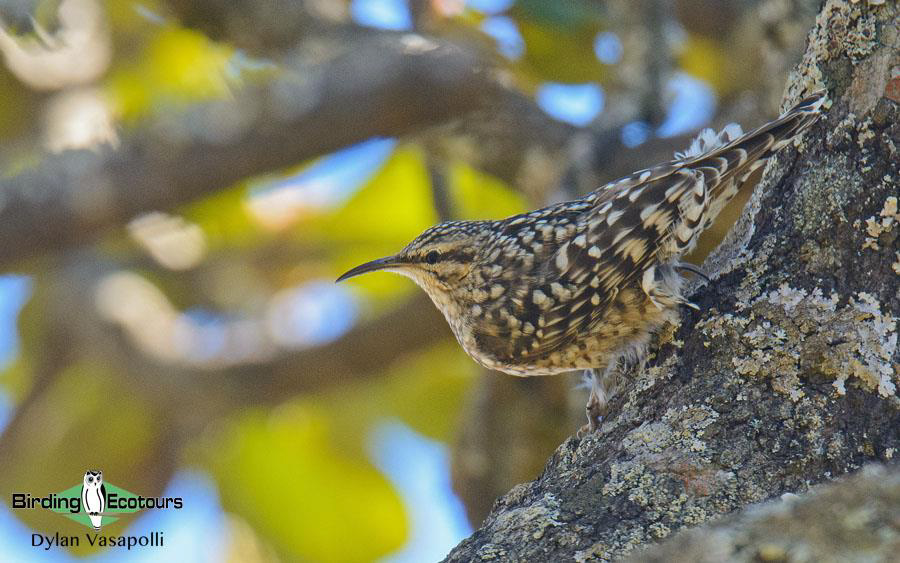
African Spotted Creeper was one of many excellent woodland birds seen in Mole.
As the days warmed up, raptors became more obvious and we were treated to numerous Bateleurs, with smaller numbers of White-backed, Hooded and White-headed Vultures. The strange open desert-like plains held the sought-after Forbes’s Plover and Sun Lark, while the wooded edges produced other scarce birds like White-fronted Black Chat, African Spotted Creeper and rare Gambaga Flycatcher. Bright Purple Starlings were numerous, and the uncommon Bronze-tailed Starlings were picked up as well. Delightful Pygmy Sunbirds were a highlight too. We spent a while trying for the shy White-throated Francolin, and eventually picked up this extremely well-camouflaged bird, skulking in the grassy zones. The bird had such confidence in its hiding abilities, it remained unmoved for some ten minutes, as it went about calling, preening, and observing – and gave everyone a good challenge to see if they could find it after taking their eyes off it!
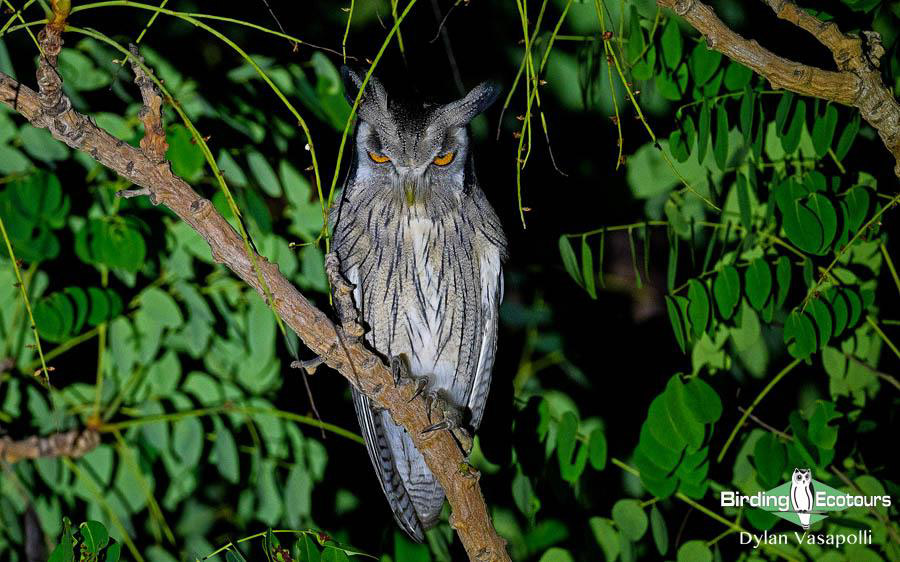
This Northern White-faced Owl gave us walk-away views!
After darkness fell, we had several night drives, and one in particular had us driving out to a particular clearing where Standard-winged Nightjar sometimes displayed from. We waited it out until, right on cue, a brilliant male Standard-winged Nightjar appeared, and put on an excellent flyby show for us – displaying its strange, winged appendages. Our sessions also gave us several owls, with African Scops Owl, Greyish Eagle-Owl and Northern White-faced Owl, and Long-tailed Nightjars proved to be common as well.
Mole National Park is also famous for its wildlife, being Ghana’s only large mammal park. African Savanna Elephants were commonly seen around the waterholes and ponds, while the woods gave us antelope such as Kob, Hartebeest and Roan Antelope. Our night drives were also good, and yielded an excellent Pardine Genet, along with a large Marsh Mongoose.
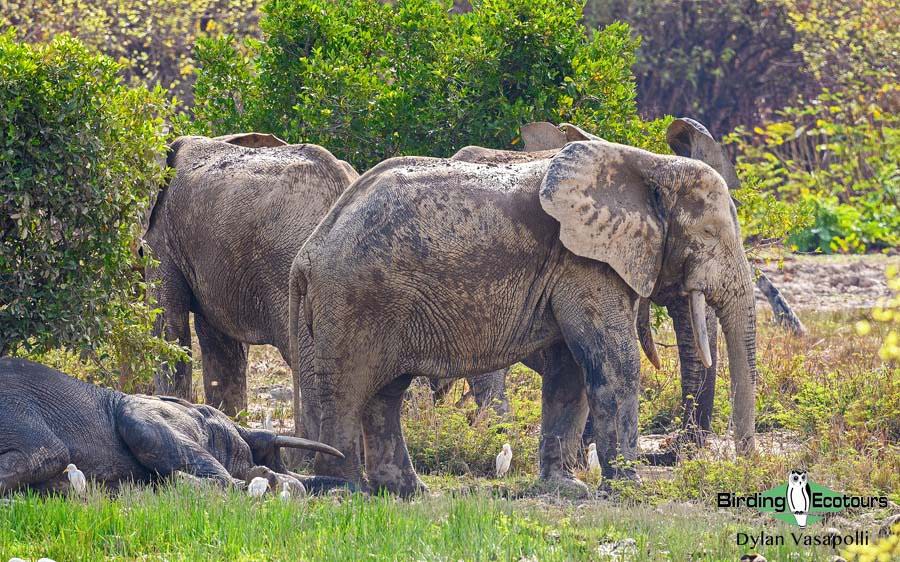
African Savanna Elephants lazing about near one of the ponds in Mole National Park.
Day 17, 16th March 2024. Birding Mole and Tongo Hills, en route to Bolga
Our time birding in Mole had been very successful, and we tried our luck at some of the few difficult birds that were still eluding us, during the early morning. Soon after sunrise, we found ourselves in a stand of mixed woodland and, in no time, we had the scarce Dorst’s Cisticola in view. We enjoyed some repeat views of other good birds like Red-winged Pytilia, Senegal Parrot, Brown-rumped Bunting and a feisty Red-winged Prinia, before we finally dug up the tiny Brown-backed Woodpecker, and an opportunistic Heuglin’s Masked Weaver stopped off. As if that wasn’t enough, the distinct bill snapping and clicks of helmetshrikes led us to a group of fine-looking White-crested Helmetshrikes.
Content, we finally made our way out of Mole, pausing for very brief looks at the old Larabanga Mosque and the accompanying Red-chested Swallows in the village. Nearby, we stopped at several roadside ponds and dams to see what was coming down to drink. Rank vegetation at one of the ponds had high numbers of small seedeaters all very intent on mobbing something on the ground – like a snake. While we couldn’t find or detect any such snake or item causing the birds’ distress, we enjoyed incredible views of a wide range of scarce species. Snazzy-looking Black-faced Firefinches were a dime a dozen, and we also enjoyed seeing them alongside others like Orange-cheeked Waxbill, Red-cheeked Cordon-bleu, Red-billed and Bar-breasted Firefinches. Bright Yellow-crowned Gonoleks dwarfed the tiny waxbills and firefinches, as did Snowy-crowned Robin-Chats, before the hulking Senegal Coucals in turn put these in their place. Another section of the dam finally gave us our hoped-for Black-rumped Waxbills, and we enjoyed large numbers coming down to drink, along with others like Red-billed Queleas. Another pan, this one much drier, held the likes of parties of African Silverbills, while Quailfinches came down to its shoreline to drink from the grass on the edge. Here we also enjoyed our first Northern Carmine Bee-eaters, as they came flying elegantly by over the pan, leaving us all in awe. The likes of Dark Chanting Goshawk and Grasshopper Buzzard also kept us company, alongside many common waterbirds.
We then settled in for the long drive to the very northern reaches of Ghana, ultimately bound for Bolgatanga, where we would spend our final days birding. In the late afternoon, right outside Bolga (as it is known) we stopped off at the Tongo Hills. An excellent flyover Fox Kestrel showed immediately, before we settled into tracking down some other targets. The birding was slow as the outside temperatures were still sweltering, though numbers of Gosling’s Bunting were out and about. The localized White-crowned Cliff Chat took some time to find, and showed only briefly to the group. Rock-loving Cisticola, on the other hand, took a herculean effort to track down, but we enjoyed extended views after we finally found one. Several other raptors showed, flying around the hills, while bright Abyssinian Rollers were a highlight as well. With the sun setting, we headed over to our comfortable hotel, and settled in for the evening.
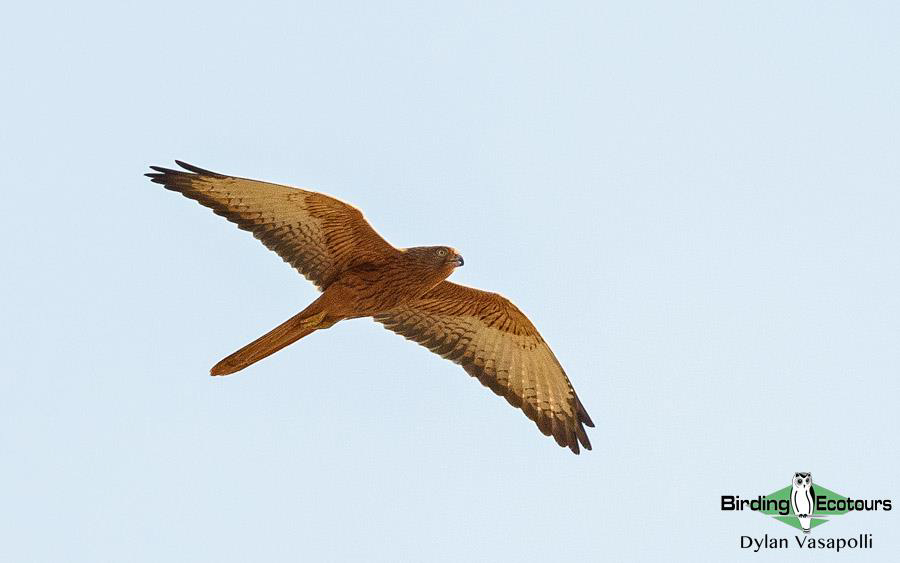
Tongo Hills provides access to a number of sought-after birds – this Fox Kestrel was one of them.
Day 18, 17th March 2024. Egyptian Plover on the Volta River
Our last full day of birding had arrived all too quickly, and we had a final early start, before pressing onwards to the White Volta River, in far northern Ghana, right on the Burkina Faso border, where the monotypic Egyptian Plover can be found. We started off birding in the productive thorn-tree scrub en-route to the river, where we spent the early morning period. Having come from the forests, and the more mature woodlands of Mole, it seemed otherworldly to be in such a dry and barren landscape. Birding was good though, and many species were seen. A Dark Chanting Goshawk eating a small mammal kicked things off, before we enjoyed some more widespread species we had seen already – Northern Red-billed Hornbill, Vieillot’s Barbet, African Grey Woodpecker, Senegal Parrot, Yellow-billed Shrike and Senegal Eremomela. A perched Woodchat Shrike was a good find, before some scurrying on the ground led us to our first Chestnut-bellied Starlings – one of our first real Sahel species (referring to the zone bordering on the edge of the mighty Sahara Desert). Nearby, we picked up more Sahel species, with groups of noisy White-billed Buffalo Weavers bouncing around, and the dainty Speckle-fronted Weavers seeking shelter. Some high-pitched calls led us to a fine Yellow Penduline Tit, which put on a good show, and just as we were winding up our birding, we lucked into a pair of Four-banded Sandgrouse, hiding on the ground. We enjoyed good sightings of both these special birds, before moving on. A large dam nearby held some common waterbirds, and importantly, some further dryland species – notably Cut-throat Finch and White-rumped Seedeater, which were coming down to drink.
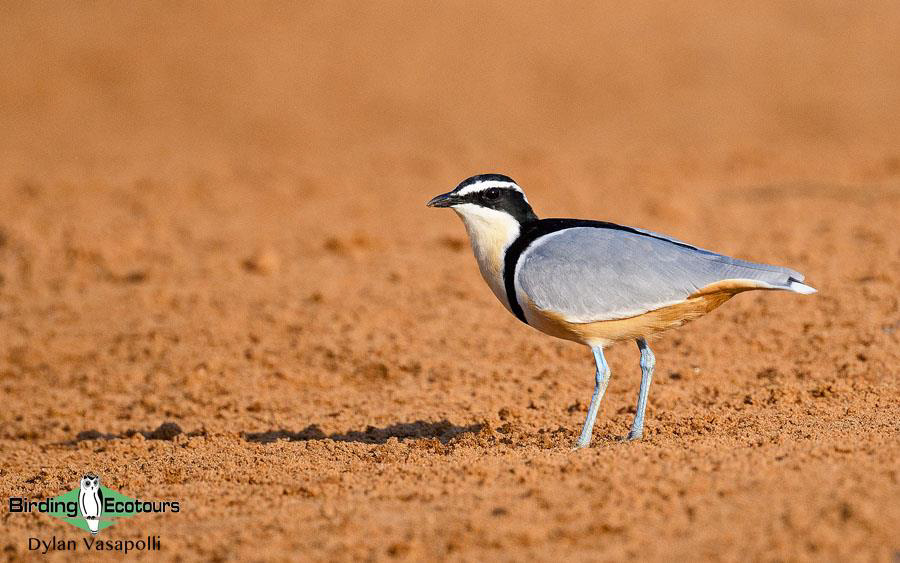
Seeing the monotypic Egyptian Plover is the main reason for us venturing to far-northern Ghana – we were not disappointed finding several pairs. We were not able to get as close to them as this photo, which is from a prior trip, however.
We pressed on to the White Volta River, and headed out to track down our main target. Despite the higher-than expected water levels, we located at least two pairs of the sought-after Egyptian Plovers in no time, and enjoyed extended scope views, watching them go about their business. The shaded river banks gave us a few other species as well, with Mourning Collared Dove, Yellow-billed Oxpecker and Greater Blue-eared Starling all added. Content with the plovers, we called it a morning, and ventured back for our customary midday rest. The afternoon saw us venturing out to the large Tono Dam, where we would spend the afternoon exploring the surrounding scrub. Although the searing heat kept activity low initially, the birding picked up. The first part of our birding was devoted to looking for the scarce Black-backed Cisticola – which took a few tries and much searching, before some of us got some brief views. Sadly, not everyone was able to see this species, try as we might. Nearby, we also ran into others like Red-winged Prinia, Purple Starling, Red-billed Firefinch, and the large Rufous-crowned Roller. The latter part of the birding saw us trying to find African Green Bee-eater – a very localized bird in Ghana. After some walking we picked up on its distinct tinkling call, and managed to get some views, before the bird disappeared. Persistence paid off, as we were able to re-find it, and enjoyed much better and more prolonged views. Some final Mottled Spinetails coming in to their roost, and a last group of Bruce’s Green Pigeons brought the day to a close. We headed back to our hotel, and enjoyed the evening, with the birding now all but complete.
Day 19, 18th March 2024. Travel back to Accra, and departure
With a midday flight from Tamale to Accra, we had a more leisurely morning with no birding plans. Following our relaxed morning, we loaded up, and made our way to Tamale, before eventually hopping onto our small airplane, and transiting back to Accra. A final dinner awaited us, as we reflected on the success of this tour, with many of the unique and localized West African species being seen, before the groups’ evening flight home.
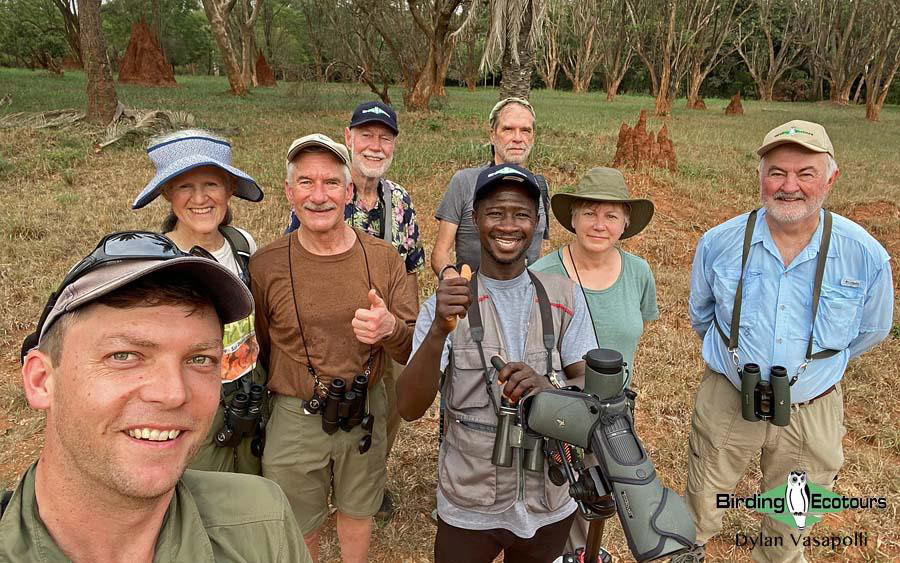
Dylan, Philip and a happy group celebrating many excellent birds.
I would like to thank the group for always keeping their heads up, despite the challenging conditions and difficult nature of this tour. It was this, and the fantastic group camaraderie, that made the tour the success it was. Birding was all-round excellent, and we ended the tour off having recorded just over 450 species of birds, with marginally under that total being seen.
Bird List – Following IOC 14.1
Birds ‘heard only’ are marked with (H) after the common name, all other species were seen.
The following notation after species names is used to show conservation status following the IUCN Red List:
CR = Critically Endangered, EN = Endangered, VU = Vulnerable.
| Common name | Scientific name |
| Ducks, Geese, Swans (Anatidae) | |
| White-faced Whistling Duck | Dendrocygna viduata |
| Hartlaub’s Duck | Pteronetta hartlaubii |
| African Pygmy Goose | Nettapus auritus |
| Guineafowl (Numididae) | |
| Helmeted Guineafowl | Numida meleagris |
| New World Quail (Odontophoridae) | |
| Stone Partridge | Ptilopachus petrosus |
| Pheasants & Allies (Phasianidae) | |
| White-throated Francolin | Campocolinus albogularis |
| Double-spurred Spurfowl | Pternistis bicalcaratus |
| Nightjars (Caprimulgidae) | |
| Brown Nightjar | Veles binotatus |
| Fiery-necked Nightjar | Caprimulgus pectoralis |
| Swamp Nightjar (H) | Caprimulgus natalensis |
| Plain Nightjar | Caprimulgus inornatus |
| Freckled Nightjar | Caprimulgus tristigma |
| Long-tailed Nightjar | Caprimulgus climacurus |
| Standard-winged Nightjar | Caprimulgus longipennis |
| Swifts (Apodidae) | |
| Mottled Spinetail | Telacanthura ussheri |
| Sabine’s Spinetail | Rhaphidura sabini |
| Cassin’s Spinetail | Neafrapus cassini |
| African Palm Swift | Cypsiurus parvus |
| Common Swift | Apus apus |
| Little Swift | Apus affinis |
| White-rumped Swift | Apus caffer |
| Bates’s Swift | Apus batesi |
| Turacos (Musophagidae) | |
| Great Blue Turaco | Corythaeola cristata |
| Western Plantain-eater | Crinifer piscator |
| Violet Turaco | Tauraco violaceus |
| Yellow-billed Turaco | Tauraco macrorhynchus |
| Guinea Turaco | Tauraco persa |
| Bustards (Otididae) | |
| Black-bellied Bustard | Lissotis melanogaster |
| Cuckoos (Cuculidae) | |
| Black-throated Coucal | Centropus leucogaster |
| Senegal Coucal | Centropus senegalensis |
| Blue-headed Coucal | Centropus monachus |
| Blue Malkoha | Ceuthmochares aereus |
| Thick-billed Cuckoo | Pachycoccyx audeberti |
| Diederik Cuckoo | Chrysococcyx caprius |
| Klaas’s Cuckoo | Chrysococcyx klaas |
| Yellow-throated Cuckoo (H) | Chrysococcyx flavigularis |
| African Emerald Cuckoo | Chrysococcyx cupreus |
| Olive Long-tailed Cuckoo | Cercococcyx olivinus |
| Black Cuckoo | Cuculus clamosus |
| African Cuckoo | Cuculus gularis |
| Sandgrouse (Pteroclidae) | |
| Four-banded Sandgrouse | Pterocles quadricinctus |
| Pigeons, Doves (Columbidae) | |
| Rock Dove | Columba livia |
| Speckled Pigeon | Columba guinea |
| Mourning Collared Dove | Streptopelia decipiens |
| Red-eyed Dove | Streptopelia semitorquata |
| Vinaceous Dove | Streptopelia vinacea |
| Laughing Dove | Spilopelia senegalensis |
| Black-billed Wood Dove | Turtur abyssinicus |
| Blue-spotted Wood Dove | Turtur afer |
| Tambourine Dove | Turtur tympanistria |
| Blue-headed Wood Dove | Turtur brehmeri |
| Namaqua Dove | Oena capensis |
| Bruce’s Green Pigeon | Treron waalia |
| African Green Pigeon | Treron calvus |
| Finfoots (Heliornithidae) | |
| African Finfoot | Podica senegalensis |
| Flufftails & Forest Rails (Sarothruridae) | |
| White-spotted Flufftail | Sarothrura pulchra |
| Rails, Crakes & Coots (Rallidae) | |
| Common Moorhen | Gallinula chloropus |
| Allen’s Gallinule | Porphyrio alleni |
| Black Crake | Zapornia flavirostra |
| Nkulengu Rail | Himantornis haematopus |
| Grebes (Podicipedidae) | |
| Little Grebe | Tachybaptus ruficollis |
| Stone-curlews, Thick-knees (Burhinidae) | |
| Senegal Thick-knee | Burhinus senegalensis |
| Stilts, Avocets (Recurvirostridae) | |
| Black-winged Stilt | Himantopus himantopus |
| Plovers (Charadriidae) | |
| Grey Plover | Pluvialis squatarola |
| Common Ringed Plover | Charadrius hiaticula |
| Forbes’s Plover | Charadrius forbesi |
| Spur-winged Lapwing | Vanellus spinosus |
| African Wattled Lapwing | Vanellus senegallus |
| Egyptian Plover (Pluvianidae) | |
| Egyptian Plover | Pluvianus aegyptius |
| Painted-snipes (Rostratulidae) | |
| Greater Painted-snipe | Rostratula benghalensis |
| Jacanas (Jacanidae) | |
| African Jacana | Actophilornis africanus |
| Sandpipers, Snipes (Scolopacidae) | |
| Eurasian Whimbrel | Numenius phaeopus |
| Bar-tailed Godwit | Limosa lapponica |
| Common Snipe | Gallinago gallinago |
| Common Sandpiper | Actitis hypoleucos |
| Green Sandpiper | Tringa ochropus |
| Marsh Sandpiper | Tringa stagnatilis |
| Wood Sandpiper | Tringa glareola |
| Common Redshank | Tringa totanus |
| Common Greenshank | Tringa nebularia |
| Ruddy Turnstone | Arenaria interpres |
| Curlew Sandpiper | Calidris ferruginea |
| Sanderling | Calidris alba |
| Little Stint | Calidris minuta |
| Coursers, Pratincoles (Glareolidae) | |
| Rock Pratincole | Glareola nuchalis |
| Collared Pratincole | Glareola pratincola |
| Gulls, Terns, Skimmers (Laridae) | |
| Common Tern | Sterna hirundo |
| Storks (Ciconiidae) | |
| African Woolly-necked Stork | Ciconia microscelis |
| Cormorants, Shags (Phalacrocoracidae) | |
| Reed Cormorant | Microcarbo africanus |
| Ibises, Spoonbills (Threskiornithidae) | |
| Spot-breasted Ibis (H) | Bostrychia rara |
| Hadada Ibis | Bostrychia hagedash |
| Herons, Bitterns (Ardeidae) | |
| White-crested Tiger Heron | Tigriornis leucolopha |
| Dwarf Bittern | Ixobrychus sturmii |
| Black-crowned Night Heron | Nycticorax nycticorax |
| Black Heron | Egretta ardesiaca |
| Little Egret | Egretta garzetta |
| Western Reef Heron | Egretta gularis |
| White-backed Night Heron | Calherodius leuconotus |
| Striated Heron | Butorides striata |
| Squacco Heron | Ardeola ralloides |
| Western Cattle Egret | Bubulcus ibis |
| Great Egret | Ardea alba |
| Yellow-billed Egret | Ardea brachyrhyncha |
| Grey Heron | Ardea cinerea |
| Black-headed Heron | Ardea melanocephala |
| Hamerkop (Scopidae) | |
| Hamerkop | Scopus umbretta |
| Kites, Hawks, Eagles (Accipitridae) | |
| Black-winged Kite | Elanus caeruleus |
| African Harrier-Hawk | Polyboroides typus |
| Palm-nut Vulture | Gypohierax angolensis |
| European Honey Buzzard | Pernis apivorus |
| African Cuckoo-Hawk | Aviceda cuculoides |
| Hooded Vulture – CR | Necrosyrtes monachus |
| White-backed Vulture – CR | Gyps africanus |
| White-headed Vulture – CR | Trigonoceps occipitalis |
| Congo Serpent Eagle | Dryotriorchis spectabilis |
| Bateleur – EN | Terathopius ecaudatus |
| Ayres’s Hawk-Eagle | Hieraaetus ayresii |
| Booted Eagle | Hieraaetus pennatus |
| Cassin’s Hawk-Eagle | Aquila africana |
| Lizard Buzzard | Kaupifalco monogrammicus |
| Dark Chanting Goshawk | Melierax metabates |
| Long-tailed Hawk | Urotriorchis macrourus |
| Red-chested Goshawk | Accipiter toussenelii |
| Shikra | Accipiter badius |
| Black Sparrowhawk | Accipiter melanoleucus |
| Western Marsh Harrier | Circus aeruginosus |
| Yellow-billed Kite | Milvus aegyptius |
| Grasshopper Buzzard | Butastur rufipennis |
| Red-necked Buzzard | Buteo auguralis |
| Barn Owls (Tytonidae) | |
| Western Barn Owl | Tyto alba |
| Owls (Strigidae) | |
| Pearl-spotted Owlet | Glaucidium perlatum |
| Red-chested Owlet (H) | Glaucidium tephronotum |
| African Barred Owlet (H) | Glaucidium capense |
| African Scops Owl | Otus senegalensis |
| Northern White-faced Owl | Ptilopsis leucotis |
| Greyish Eagle-Owl | Bubo cinerascens |
| Fraser’s Eagle-Owl | Ketupa poensis |
| Akun Eagle-Owl | Ketupa leucosticta |
| African Wood Owl | Strix woodfordii |
| Trogons (Trogonidae) | |
| Narina Trogon | Apaloderma narina |
| Wood Hoopoes (Phoeniculidae) | |
| Forest Wood Hoopoe | Phoeniculus castaneiceps |
| White-headed Wood Hoopoe | Phoeniculus bollei |
| Green Wood Hoopoe | Phoeniculus purpureus |
| Black Scimitarbill | Rhinopomastus aterrimus |
| Ground Hornbills (Bucorvidae) | |
| Abyssinian Ground Hornbill – VU | Bucorvus abyssinicus |
| Hornbills (Bucerotidae) | |
| Northern Red-billed Hornbill | Tockus erythrorhynchus |
| West African Pied Hornbill | Lophoceros semifasciatus |
| African Grey Hornbill | Lophoceros nasutus |
| Red-billed Dwarf Hornbill | Lophoceros camurus |
| Piping Hornbill | Bycanistes fistulator |
| Brown-cheeked Hornbill – VU | Bycanistes cylindricus |
| Black-casqued Hornbill | Ceratogymna atrata |
| Yellow-casqued Hornbill – VU | Ceratogymna elata |
| Western Dwarf Hornbill | Horizocerus hartlaubi |
| Western Long-tailed Hornbill | Horizocerus albocristatus |
| Rollers (Coraciidae) | |
| Purple Roller | Coracias naevius |
| Abyssinian Roller | Coracias abyssinicus |
| Blue-bellied Roller | Coracias cyanogaster |
| Blue-throated Roller | Eurystomus gularis |
| Broad-billed Roller | Eurystomus glaucurus |
| Kingfishers (Alcedinidae) | |
| Chocolate-backed Kingfisher | Halcyon badia |
| Grey-headed Kingfisher | Halcyon leucocephala |
| Striped Kingfisher | Halcyon chelicuti |
| Blue-breasted Kingfisher | Halcyon malimbica |
| Woodland Kingfisher | Halcyon senegalensis |
| African Dwarf Kingfisher (H) | Ispidina lecontei |
| African Pygmy Kingfisher | Ispidina picta |
| White-bellied Kingfisher | Corythornis leucogaster |
| Malachite Kingfisher | Corythornis cristatus |
| Shining-blue Kingfisher | Alcedo quadribrachys |
| Giant Kingfisher | Megaceryle maxima |
| Pied Kingfisher | Ceryle rudis |
| Bee-eaters (Meropidae) | |
| Blue-moustached Bee-eater | Merops mentalis |
| Black Bee-eater | Merops gularis |
| Swallow-tailed Bee-eater | Merops hirundineus |
| Little Bee-eater | Merops pusillus |
| Red-throated Bee-eater | Merops bulocki |
| White-throated Bee-eater | Merops albicollis |
| African Green Bee-eater | Merops viridissimus |
| Rosy Bee-eater | Merops malimbicus |
| Northern Carmine Bee-eater | Merops nubicus |
| African Barbets (Lybiidae) | |
| Yellow-billed Barbet | Trachyphonus purpuratus |
| Bristle-nosed Barbet | Gymnobucco peli |
| Naked-faced Barbet | Gymnobucco calvus |
| Speckled Tinkerbird | Pogoniulus scolopaceus |
| Red-rumped Tinkerbird | Pogoniulus atroflavus |
| Yellow-throated Tinkerbird | Pogoniulus subsulphureus |
| Yellow-rumped Tinkerbird | Pogoniulus bilineatus |
| Yellow-fronted Tinkerbird | Pogoniulus chrysoconus |
| Yellow-spotted Barbet | Buccanodon duchaillui |
| Hairy-breasted Barbet | Tricholaema hirsuta |
| Vieillot’s Barbet | Lybius vieilloti |
| Double-toothed Barbet | Pogonornis bidentatus |
| Bearded Barbet | Pogonornis dubius |
| Honeyguides (Indicatoridae) | |
| Cassin’s Honeybird | Prodotiscus insignis |
| Yellow-footed Honeyguide (H) | Melignomon eisentrauti |
| Willcocks’s Honeyguide | Indicator willcocksi |
| Lesser Honeyguide | Indicator minor |
| Greater Honeyguide | Indicator indicator |
| Woodpeckers (Picidae) | |
| African Piculet | Verreauxia africana |
| Buff-spotted Woodpecker | Pardipicus nivosus |
| Brown-eared Woodpecker | Pardipicus caroli |
| Fine-spotted Woodpecker | Campethera punctuligera |
| Little Green Woodpecker | Campethera maculosa |
| Fire-bellied Woodpecker | Chloropicus pyrrhogaster |
| Cardinal Woodpecker | Dendropicos fuscescens |
| Melancholy Woodpecker | Dendropicos lugubris |
| African Grey Woodpecker | Dendropicos goertae |
| Brown-backed Woodpecker | Dendropicos obsoletus |
| Caracaras, Falcons (Falconidae) | |
| Common Kestrel | Falco tinnunculus |
| Fox Kestrel | Falco alopex |
| Grey Kestrel | Falco ardosiaceus |
| African Hobby | Falco cuvierii |
| Lanner Falcon | Falco biarmicus |
| African & New World Parrots (Psittacidae) | |
| Grey Parrot – EN | Psittacus erithacus |
| Red-fronted Parrot | Poicephalus gulielmi |
| Senegal Parrot | Poicephalus senegalus |
| Old World Parrots (Psittaculidae) | |
| Rose-ringed Parakeet | Psittacula krameri |
| Red-headed Lovebird | Agapornis pullarius |
| African & Green Broadbills (Calyptomenidae) | |
| Rufous-sided Broadbill | Smithornis rufolateralis |
| Wattle-eyes, Batises (Platysteiridae) | |
| Senegal Batis | Batis senegalensis |
| West African Batis | Batis occulta |
| West African Wattle-eye | Platysteira hormophora |
| Brown-throated Wattle-eye | Platysteira cyanea |
| Red-cheeked Wattle-eye | Platysteira blissetti |
| Bushshrikes (Malaconotidae) | |
| Fiery-breasted Bushshrike | Malaconotus cruentus |
| Grey-headed Bushshrike | Malaconotus blanchoti |
| Orange-breasted Bushshrike | Chlorophoneus sulfureopectus |
| Marsh Tchagra | Bocagia minuta |
| Brown-crowned Tchagra | Tchagra australis |
| Black-crowned Tchagra | Tchagra senegalus |
| Sabine’s Puffback | Dryoscopus sabini |
| Northern Puffback | Dryoscopus gambensis |
| Lowland Sooty Boubou | Laniarius leucorhynchus |
| Tropical Boubou | Laniarius major |
| Yellow-crowned Gonolek | Laniarius barbarus |
| Brubru | Nilaus afer |
| Vangas & Allies (Vangidae) | |
| White-crested Helmetshrike | Prionops plumatus |
| Red-billed Helmetshrike | Prionops caniceps |
| Black-and-white Shrike-flycatcher | Bias musicus |
| Cuckooshrikes (Campephagidae) | |
| Purple-throated Cuckooshrike | Campephaga quiscalina |
| Blue Cuckooshrike | Cyanograucalus azureus |
| Figbirds, Old World Orioles, Piopios (Oriolidae) | |
| Western Oriole | Oriolus brachyrynchus |
| Black-winged Oriole | Oriolus nigripennis |
| African Golden Oriole | Oriolus auratus |
| Drongos (Dicruridae) | |
| Velvet-mantled Drongo | Dicrurus modestus |
| Fork-tailed Drongo | Dicrurus adsimilis |
| Shining Drongo | Dicrurus atripennis |
| Monarchs (Monarchidae) | |
| Blue-headed Crested Flycatcher | Trochocercus nitens |
| Red-bellied Paradise Flycatcher | Terpsiphone rufiventer |
| African Paradise Flycatcher | Terpsiphone viridis |
| Shrikes (Laniidae) | |
| Yellow-billed Shrike | Lanius corvinus |
| Northern Fiscal | Lanius humeralis |
| Woodchat Shrike | Lanius senator |
| Crows, Jays (Corvidae) | |
| Piapiac | Ptilostomus afer |
| Pied Crow | Corvus albus |
| Rockfowl (Picathartidae) | |
| White-necked Rockfowl – VU | Picathartes gymnocephalus |
| Fairy Flycatchers (Stenostiridae) | |
| African Blue Flycatcher | Elminia longicauda |
| Tits, Chickadees (Paridae) | |
| White-shouldered Black Tit | Melaniparus guineensis |
| Penduline Tits (Remizidae) | |
| Yellow Penduline Tit | Anthoscopus parvulus |
| Forest Penduline Tit | Anthoscopus flavifrons |
| Nicators (Nicatoridae) | |
| Western Nicator | Nicator chloris |
| Larks (Alaudidae) | |
| Flappet Lark | Mirafra rufocinnamomea |
| Sun Lark | Galerida modesta |
| Bulbuls (Pycnonotidae) | |
| Slender-billed Greenbul | Stelgidillas gracilirostris |
| Golden Greenbul | Calyptocichla serinus |
| Red-tailed Bristlebill | Bleda syndactylus |
| Green-tailed Bristlebill | Bleda eximius |
| Grey-headed Bristlebill | Bleda canicapillus |
| Yellow-throated Leaflove | Atimastillas flavicollis |
| Spotted Greenbul | Ixonotus guttatus |
| Swamp Palm Bulbul | Thescelocichla leucopleura |
| Simple Greenbul | Chlorocichla simplex |
| Honeyguide Greenbul | Baeopogon indicator |
| Western Bearded Greenbul | Criniger barbatus |
| Red-tailed Greenbul | Criniger calurus |
| Yellow-bearded Greenbul – VU | Criniger olivaceus |
| Little Greenbul | Eurillas virens |
| Yellow-whiskered Greenbul | Eurillas latirostris |
| Plain Greenbul | Eurillas curvirostris |
| Little Grey Greenbul | Eurillas gracilis |
| Ansorge’s Greenbul | Eurillas ansorgei |
| White-throated Greenbul (H) | Phyllastrephus albigularis |
| Icterine Greenbul | Phyllastrephus icterinus |
| Common Bulbul | Pycnonotus barbatus |
| Swallows, Martins (Hirundinidae) | |
| Square-tailed Saw-wing | Psalidoprocne nitens |
| Fanti Saw-wing | Psalidoprocne obscura |
| Pied-winged Swallow | Hirundo leucosoma |
| Barn Swallow | Hirundo rustica |
| Red-chested Swallow | Hirundo lucida |
| Ethiopian Swallow | Hirundo aethiopica |
| White-bibbed Swallow | Hirundo nigrita |
| Wire-tailed Swallow | Hirundo smithii |
| Western House Martin | Delichon urbicum |
| Lesser Striped Swallow | Cecropis abyssinica |
| Preuss’s Cliff Swallow | Petrochelidon preussi |
| Crombecs, African Warblers (Macrosphenidae) | |
| Moustached Grass Warbler | Melocichla mentalis |
| Kemp’s Longbill | Macrosphenus kempi |
| Grey Longbill | Macrosphenus concolor |
| Northern Crombec | Sylvietta brachyura |
| Green Crombec | Sylvietta virens |
| Lemon-bellied Crombec | Sylvietta denti |
| Yellow Flycatchers (Erythrocercidae) | |
| Chestnut-capped Flycatcher | Erythrocercus mccallii |
| Hylias (Hyliidae) | |
| Green Hylia | Hylia prasina |
| Tit Hylia | Pholidornis rushiae |
| Leaf Warblers (Phylloscopidae) | |
| Wood Warbler | Phylloscopus sibilatrix |
| Willow Warbler | Phylloscopus trochilus |
| Reed Warblers & Allies (Acrocephalidae) | |
| Sedge Warbler | Acrocephalus schoenobaenus |
| Common Reed Warbler | Acrocephalus scirpaceus |
| Cisticolas & Allies (Cisticolidae) | |
| Red-faced Cisticola | Cisticola erythrops |
| Singing Cisticola | Cisticola cantans |
| Whistling Cisticola | Cisticola lateralis |
| Rock-loving Cisticola | Cisticola emini |
| Croaking Cisticola | Cisticola natalensis |
| Dorst’s Cisticola | Cisticola guinea |
| Rufous Cisticola | Cisticola rufus |
| Black-backed Cisticola | Cisticola eximius |
| Tawny-flanked Prinia | Prinia subflava |
| Red-winged Prinia | Prinia erythroptera |
| Yellow-breasted Apalis | Apalis flavida |
| Black-capped Apalis | Apalis nigriceps |
| Sharpe’s Apalis | Apalis sharpii |
| Oriole Warbler | Hypergerus atriceps |
| Grey-backed Camaroptera | Camaroptera brevicaudata |
| Yellow-browed Camaroptera | Camaroptera superciliaris |
| Olive-green Camaroptera | Camaroptera chloronota |
| Senegal Eremomela | Eremomela pusilla |
| White-eyes (Zosteropidae) | |
| Northern Yellow White-eye | Zosterops senegalensis |
| Ground Babblers (Pellorneidae) | |
| Brown Illadopsis | Illadopsis fulvescens |
| Pale-breasted Illadopsis | Illadopsis rufipennis |
| Blackcap Illadopsis | Illadopsis cleaveri |
| Puvel’s Illadopsis | Illadopsis puveli |
| Rufous-winged Illadopsis | Illadopsis rufescens |
| Laughingthrushes & Allies (Leiothrichidae) | |
| Brown Babbler | Turdoides plebejus |
| Blackcap Babbler | Turdoides reinwardtii |
| Hyliotas (Hyliotidae) | |
| Yellow-bellied Hyliota | Hyliota flavigaster |
| Violet-backed Hyliota | Hyliota violacea |
| Treecreepers (Certhiidae) | |
| African Spotted Creeper | Salpornis salvadori |
| Starlings, Rhabdornises (Sturnidae) | |
| Copper-tailed Starling | Hylopsar cupreocauda |
| Greater Blue-eared Starling | Lamprotornis chalybaeus |
| Bronze-tailed Starling | Lamprotornis chalcurus |
| Splendid Starling | Lamprotornis splendidus |
| Purple Starling | Lamprotornis purpureus |
| Long-tailed Glossy Starling | Lamprotornis caudatus |
| Chestnut-bellied Starling | Lamprotornis pulcher |
| Violet-backed Starling | Cinnyricinclus leucogaster |
| Chestnut-winged Starling | Onychognathus fulgidus |
| Narrow-tailed Starling | Poeoptera lugubris |
| Oxpeckers (Buphagidae) | |
| Yellow-billed Oxpecker | Buphagus africanus |
| Thrushes (Turdidae) | |
| Finsch’s Rufous Thrush | Stizorhina finschi |
| White-tailed Ant Thrush | Neocossyphus poensis |
| African Thrush | Turdus pelios |
| Chats, Old World Flycatchers (Muscicapidae) | |
| White-tailed Alethe | Alethe diademata |
| Pale Flycatcher | Agricola pallidus |
| Fraser’s Forest Flycatcher | Fraseria ocreata |
| Grey-throated Tit-Flycatcher | Fraseria griseigularis |
| Tessmann’s Flycatcher | Fraseria tessmanni |
| Northern Black Flycatcher | Melaenornis edolioides |
| Dusky-blue Flycatcher | Bradornis comitatus |
| Ussher’s Flycatcher | Bradornis ussheri |
| Spotted Flycatcher | Muscicapa striata |
| Gambaga Flycatcher | Muscicapa gambagae |
| Cassin’s Flycatcher | Muscicapa cassini |
| Swamp Flycatcher | Muscicapa aquatica |
| Forest Robin | Stiphrornis erythrothorax |
| White-crowned Robin-Chat | Cossypha albicapillus |
| Snowy-crowned Robin-Chat | Cossypha niveicapilla |
| Blue-shouldered Robin-Chat | Cossypha cyanocampter |
| European Pied Flycatcher | Ficedula hypoleuca |
| Common Redstart | Phoenicurus phoenicurus |
| Whinchat | Saxicola rubetra |
| White-crowned Cliff Chat | Thamnolaea coronata |
| White-fronted Black Chat | Oenanthe albifrons |
| Familiar Chat | Oenanthe familiaris |
| Sunbirds (Nectariniidae) | |
| Fraser’s Sunbird | Deleornis fraseri |
| Mangrove Sunbird | Anthreptes gabonicus |
| Western Violet-backed Sunbird | Anthreptes longuemarei |
| Little Green Sunbird | Anthreptes seimundi |
| Yellow-chinned Sunbird | Anthreptes rectirostris |
| Collared Sunbird | Hedydipna collaris |
| Pygmy Sunbird | Hedydipna platura |
| Reichenbach’s Sunbird | Anabathmis reichenbachii |
| Green-headed Sunbird | Cyanomitra verticalis |
| Blue-throated Brown Sunbird | Cyanomitra cyanolaema |
| Olive Sunbird | Cyanomitra olivacea |
| Buff-throated Sunbird | Chalcomitra adelberti |
| Scarlet-chested Sunbird | Chalcomitra senegalensis |
| Olive-bellied Sunbird | Cinnyris chloropygius |
| Tiny Sunbird | Cinnyris minullus |
| Beautiful Sunbird | Cinnyris pulchellus |
| Splendid Sunbird | Cinnyris coccinigastrus |
| Johanna’s Sunbird | Cinnyris johannae |
| Superb Sunbird | Cinnyris superbus |
| Copper Sunbird | Cinnyris cupreus |
| Old World Sparrows, Snowfinches (Passeridae) | |
| Sahel Bush Sparrow | Gymnoris dentata |
| Northern Grey-headed Sparrow | Passer griseus |
| House Sparrow | Passer domesticus |
| Weavers, Widowbirds (Ploceidae) | |
| White-billed Buffalo Weaver | Bubalornis albirostris |
| Chestnut-crowned Sparrow-Weaver (H) | Plocepasser superciliosus |
| Speckle-fronted Weaver | Sporopipes frontalis |
| Thick-billed Weaver | Amblyospiza albifrons |
| Little Weaver | Ploceus luteolus |
| Olive-naped Weaver | Ploceus brachypterus |
| Orange Weaver | Ploceus aurantius |
| Heuglin’s Masked Weaver | Ploceus heuglini |
| Village Weaver | Ploceus cucullatus |
| Chestnut-and-black Weaver | Ploceus castaneofuscus |
| Black-headed Weaver | Ploceus melanocephalus |
| Yellow-mantled Weaver | Ploceus tricolor |
| Maxwell’s Black Weaver | Ploceus albinucha |
| Compact Weaver | Ploceus superciliosus |
| Preuss’s Weaver | Ploceus preussi |
| Red-vented Malimbe | Malimbus scutatus |
| Blue-billed Malimbe | Malimbus nitens |
| Red-headed Malimbe | Malimbus rubricollis |
| Crested Malimbe | Malimbus malimbicus |
| Red-headed Weaver | Anaplectes rubriceps |
| Red-billed Quelea | Quelea quelea |
| Black-winged Red Bishop | Euplectes hordeaceus |
| Northern Red Bishop | Euplectes franciscanus |
| Yellow-mantled Widowbird | Euplectes macroura |
| Waxbills, Munias & Allies (Estrildidae) | |
| Bronze Mannikin | Spermestes cucullata |
| Magpie Mannikin (H) | Spermestes fringilloides |
| Black-and-white Mannikin | Spermestes bicolor |
| African Silverbill | Euodice cantans |
| Red-fronted Antpecker (H) | Parmoptila rubrifrons |
| White-breasted Nigrita | Nigrita fusconotus |
| Chestnut-breasted Nigrita | Nigrita bicolor |
| Grey-headed Nigrita | Nigrita canicapillus |
| Lavender Waxbill | Glaucestrilda caerulescens |
| Orange-cheeked Waxbill | Estrilda melpoda |
| Black-rumped Waxbill | Estrilda troglodytes |
| Quailfinch | Ortygospiza atricollis |
| Cut-throat Finch | Amadina fasciata |
| Red-cheeked Cordon-bleu | Uraeginthus bengalus |
| Western Bluebill | Spermophaga haematina |
| Black-bellied Seedcracker | Pyrenestes ostrinus |
| Red-winged Pytilia | Pytilia phoenicoptera |
| Red-billed Firefinch | Lagonosticta senegala |
| African Firefinch | Lagonosticta rubricata |
| Bar-breasted Firefinch | Lagonosticta rufopicta |
| Black-faced Firefinch | Lagonosticta larvata |
| Indigobirds, Whydahs (Viduidae) | |
| Village Indigobird | Vidua chalybeata |
| Wilson’s Indigobird | Vidua wilsoni |
| Pin-tailed Whydah | Vidua macroura |
| Togo Paradise Whydah | Vidua togoensis |
| Wagtails, Pipits (Motacillidae) | |
| Western Yellow Wagtail | Motacilla flava |
| African Pied Wagtail | Motacilla aguimp |
| Yellow-throated Longclaw | Macronyx croceus |
| Plain-backed Pipit | Anthus leucophrys |
| Finches, Euphonias (Fringillidae) | |
| White-rumped Seedeater | Crithagra leucopygia |
| Yellow-fronted Canary | Crithagra mozambica |
| West African Seedeater | Crithagra canicapilla |
| Buntings (Emberizidae) | |
| Gosling’s Bunting | Emberiza goslingi |
| Brown-rumped Bunting | Emberiza affinis |
| Species seen: | 444 |
| Species heard: | 11 |
| Total recorded: | 455 |
Mammal List – Following Mammalwatching.com
Mammals ‘heard only’ are marked with (H) after the common name, all other species were seen.
The following notation after species names is used to show conservation status following the IUCN Red List:
EN = Endangered.
| Common name | Scientific name |
| Elephants (Elephantidae) | |
| African Savanna Elephant – EN | Loxodonta africana |
| Hyraxes (Procaviidae) | |
| Western Tree Hyrax (H) | Dendrohyrax dorsalis |
| Old World Monkeys (Cercopithecidae) | |
| Spot-nosed Monkey | Cercopithecus petaurista |
| Green Monkey | Chlorocebus sabaeus |
| Common Patas Monkey | Erythrocebus patas |
| Olive Baboon | Papio anubis |
| Galagos (Galagidae) | |
| Northern Lesser Galago | Galago senegalensis |
| Demidoff’s Dwarf Galago | Galagoides demidoff |
| Hares and Rabbits (Leporidae) | |
| African Savanna Hare | Lepus microtis |
| Squirrels (Sciuridae) | |
| Fire-footed Rope Squirrel | Funisciurus pyrropus |
| Kintampo Rope Squirrel | Funisciurus substriatus |
| Gambian Sun Squirrel | Heliosciurus gambianus |
| Red-legged Sun Squirrel | Heliosciurus rufobrachium |
| Green Bush Squirrel | Paraxerus poensis |
| Forest Giant Squirrel | Protoxerus stangeri |
| Striped Ground Squirrel | Euxerus erythropus |
| Nesomyids (Nesomyidae) | |
| Northern Giant Pouched Rat | Cricetomys gambianus |
| Old World Fruit Bats (Pteropodidae) | |
| African Straw-colored Fruit Bat | Eidolon helvum |
| False Vampire Bats (Megadermatidae) | |
| Yellow-winged False-vampire | Lavia frons |
| Sheath-tailed Bats (Emballonuridae) | |
| Egyptian Tomb Bat | Taphozous perforatus |
| Mongooses (Herpestidae) | |
| Marsh Mongoose | Atilax paludinosus |
| Gambian Mongoose | Mungos gambianus |
| Civets, Genets, and Oyans (Viverridae) | |
| Pardine Genet | Genetta pardina |
| Bovids (Bovidae) | |
| Hartebeest | Alcelaphus buselaphus |
| Bush Duiker | Sylvicapra grimmia |
| Roan Antelope | Hippotragus equinus |
| Kob | Kobus kob |
| Northern Bushbuck | Tragelaphus scriptus |
| Suids (Suidae) | |
| Common Warthog | Phacochoerus africanus |
| Species seen: | 28 |
| Species heard: | 1 |
| Total recorded: | 29 |
Reptile List
| Common name | Scientific name |
| Crocodiles (Crocodylidae) | |
| Nile Crocodile | Crocodylus niloticus |
| Dwarf Crocodile – VU | Osteolaemus tetraspis |
| Dragons (Agamidae) | |
| Peters’s Rock Agama | Agama picticauda |
| Monitor Lizards (Varanidae) | |
| Nile Monitor | Varanus niloticus |
| Atractaspidid Snakes (Atractaspididae) | |
| Fat Burrowing Asp | Atractaspis corpulenta |
| Species seen: | 5 |
| Total recorded: | 5 |
This is a sample trip report. Please email us ([email protected]) for more trip reports from this destination.
